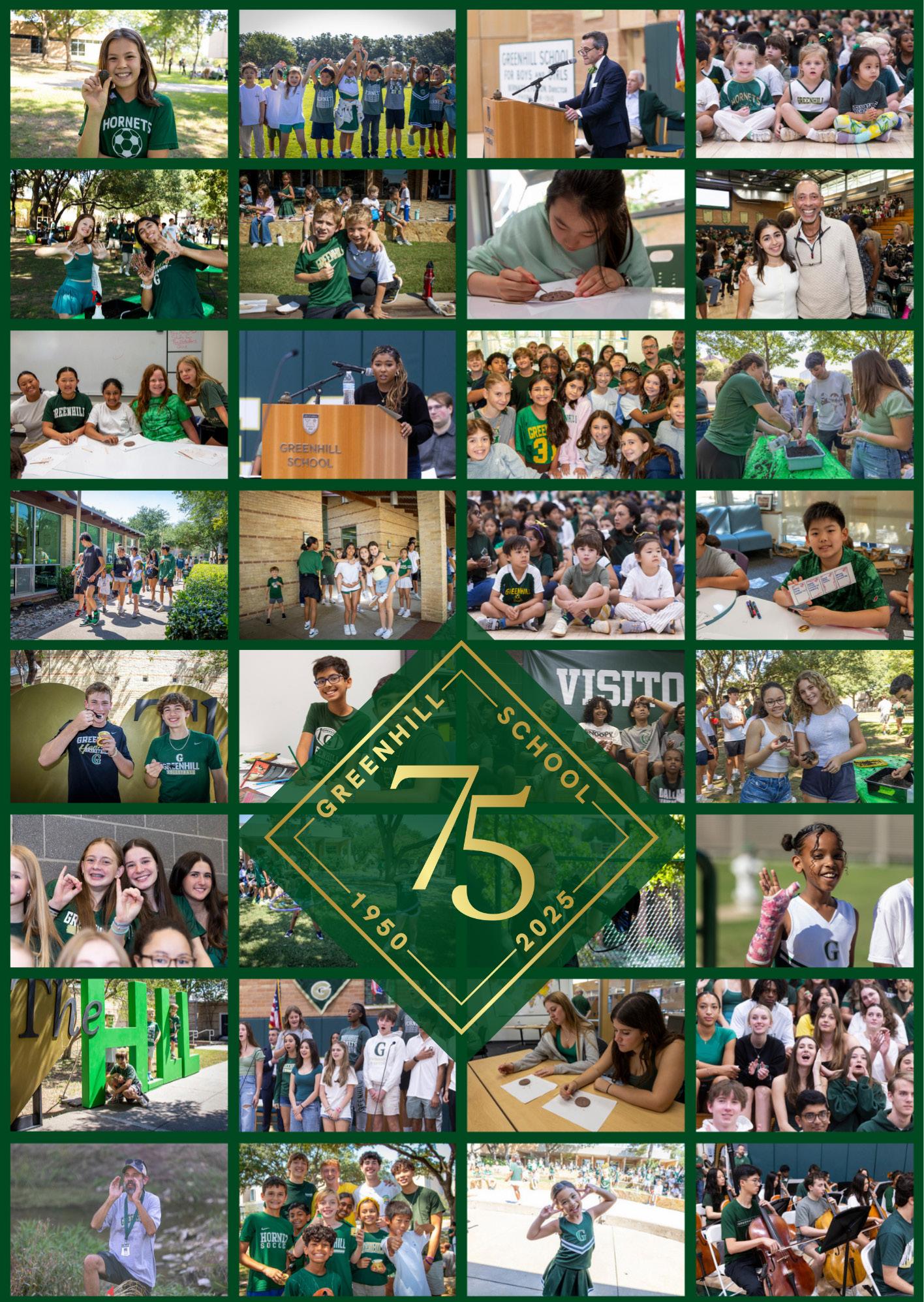

02 News
75 Years on the Hill
Kate Ponnambalam
On Sept. 11, Greenhill hosted an all-day celebration where students, faculty, parents and alumni gathered to commemorate the 75th anniversary of the school’s founding by Bernard Fulton and his wife, Helen.
Bernard Fulton served as chairman of the Addison Independent School District board for 10 years before founding Greenhill. He then served as Greenhill’s first headmaster – now head of school – from 1950-1976. During that time, the school’s enrollment grew from 62 students to 1,002 students, according to an official “Faces of Greenhill” profile prepared for the 75th anniversary celebrations.
“Founders Day just seemed like the day to really celebrate in a significant way,” Associate Head of School for Mission, Community and Culture Tom Perryman ’81 said. “We wanted to do something that involved the whole school beyond just an assembly.”
Assembly
Founders Day began with an all-school assembly from 8:15 a.m.-9:30 a.m. At 8:29 a.m., Perryman and two of Bernard and Helen Fulton’s children presided over a countdown that culminated at precisely 8:30 a.m., the moment Greenhill’s first classes started in 1950.
The two Fulton children, Molly Fulton Seeligson ’60 and William Fulton ’68, rang the same bell their mother had rung on the school’s first day. A video of Bernard Fulton, recorded at age 99 before his death in 2009, showed the founder recounting Greenhill’s earliest years alongside his wife.
The Greenhill Band and Orchestra performed, premiering “Peacock Fanfare,” a commissioned piece composed by Michael Paraskevas ’10, an accomplished Hollywood film composer and son of Nick Paraskevas, longtime director of the Greenhill Orchestra. The Greenhill Choir joined the instrumentalists to lead the community in singing the “Star-Spangled Banner,” “Let There be Peace on Earth,” “Best Friends” and “Hail to Greenhill.”
Perryman recognized alumni throughout the program. Alumni Board President Lee Szor ’03 was among the speakers who delivered remarks.
“Hopefully seeing alumni return on Founders Day reminds [students] that this is a lifelong connection,” Director of Alumni Relations Katie Young said. “Even after they graduate, they are still connected to Greenhill in so many ways.”
“
Founders
Day just seemed like the day to really celebrate in a significant way. We wanted to do something that involved the whole school beyond just an assembly.”
Szor introduced the perennial Greenhill favorite, “Best Friends.” During each year’s celebration, students, faculty and others put an arm around their neighbors’ shoulders and sway back and forth during the sentimental song.
“Singing ‘Best Friends’ for the last time hurt me more than I thought it would, and I’ll forever remember that as an important Greenhill tradition,” senior Davis Knocke said.
The assembly also included speeches from student body president Hazel Goes-Young and Greenhill’s longest-tenured employee, Ron Ivery of the campus facilities team. After their remarks, Goes-Young, Ivery and Szor joined in a candlelighting ceremony representing community members.

Among the featured student speakers were seniors Valentina Casas-Sayek and Hank Utay and eighth graders Aurelio Pereira and Tia Samanta. Each told the story of a former member of the Greenhill community whose contributions were being honored by naming a campus Heart of the Hill group after them. The four honorees were Steve Blanchard, Clarice Nichols, Tony Torrance and Tom Holadak.
Senior Helen Reed also delivered a tribute to Estelle Dickens, a former faculty member. The school dedicated the Founders Day service project to Dickens, an advocate for community engagement during her 44-year tenure.
The assembly concluded with instructions for the next event: an aerial photograph of the school community arranged in a giant 75 on Brinkmann Field.
“We wanted to create a memory and freeze this moment in time for the future,” Perryman said.
Service, Art and Stewardship
After the assembly, all students completed three rotations across campus that involved acts of service, art and campus stewardship.
As service, students assembled learning kits for English language learners at George H. W. Bush Elementary School, Greenhill’s next-door neighbor. Director of Service Learning and Community Engagement Jessica Chu said the project grew directly from conversations with administrators at the Dallas Independent School District school.
“During the summer, I met with the Bush administration and asked them, ‘if we have 1,500 people ready and willing to serve, what would be helpful?’” Chu said. “They shared that they have a huge English language learning population that would benefit from educational kits to enhance their English skills.”
In the art rotation, students crafted clay disks that will become part of a pathway in the school’s emerging prairie

area, which features native plants and an outdoor learning space near the Marshall Family Performing Arts Center.
Lower School Visual Art teacher Mary Aidala, who organized the project, said she focused on an activity that was both accessible and engaging for all ages.
“My students always get the most excited about clay,” Aidala said. “And even for older students who may not take art anymore, clay feels special.”
When fired, the clay’s natural tones will echo the earthy palette used by O’Neil Ford, the architect who designed Crossman Dining Hall, Cox Gym and Montgomery Library.
“I love the idea that our youngest students all the way up to our seniors, and even the adults working with them, could each contribute a piece that forms a much larger work,” Aidala said.
Perryman said the project reflects Greenhill’s effort to leave an enduring mark during its milestone year.
“We decided we wanted to do an art project to create something that would be lasting on this campus,” Perryman said. “So that when folks are gathering for the 100th anniversary, there still will be a piece of art created by us.”
The third rotation highlighted Greenhill’s commitment to sustainability through two hands-on activities: learning from environmentalists and restoring native habitats. Organized by Middle School history teacher Kara Smith, Middle School science teachers Gretchen Pollom and Susan Eve and Upper School English teacher Trey Colvin, the rotation introduced students to ecosystems on campus.
Six stations staffed by Texas master naturalists focused on prairies, wetlands and forests, as well as pollinators, birds and mammals. Students circulated among the tables, hearing from specialists about biodiversity and the role each species plays in the native ecosystem of North Texas.
After the presentations, students made seed balls from Greenhill’s own soil mixed with native Blackland Prairie seeds, including bluebonnets and painted cup plants. The students tossed the seed balls onto the bank of the creek that flows through campus.
Smith said the experience connected directly to Greenhill’s mission.
“To be able to celebrate Founders Day by actually having our hands in clay from Greenhill and then literally planting seeds that we can watch grow — it’s a great metaphor for education and for what the founders intended,” Smith said.
To conclude the day, students gathered in their Heart of the Hill groups and ate ice cream together, a throwback to the ice cream socials Helen Fulton hosted for Greenhill’s earliest students.
“I’ve seen this tradition evolve over the years, from when I was in kindergarten to now as a senior, and each year it reminds me of how these simple, joyful experiences help unite our campus and strengthen the bonds that go beyond the classroom,” senior Kendall Johnson said.
Reflection
During the 75th Founders Day, the Greenhill community broke with tradition to pause academic life for an entire day to celebrate the school’s values and the people who have embodied those values, past and present.
“I think, first of all, it’s important to get the whole school together, three-year-olds to 18-year-olds, current and retired faculty, so we can tell the family story,” Perryman said in the days before the celebration he helped plan and direct. “This place was around before we got here, and this place hopefully will be around long after we leave.”
Renovations in Academic and Dining Spaces
Over the summer, both the Fulton Upper School Building – also known as Upper School South – and the Crossman Dining Hall were renovated to better suit students’ needs.
When the Rosa O. Valdes STEM + Innovation Center opened in the spring of 2024, all math, science and innovation classrooms were cleared out of the Upper School South 300 pod, leaving empty spaces in their wake.
Head of School Lee Hark, Head of Upper School Trevor Worcester and Associate Head of School/Chief Financial Officer/Chief Operating Officer Kendra Grace began to envision how the space might be reimagined.
“We wanted to redesign [Upper School
South] to make it more student focused and to help it be a better support for the students,” Grace said.
While the new furniture is in the process of being installed, the vision for the center of the 300 pod is to create a place where teachers could complete their tasks at their workstations and students could collaborate outside their classrooms.
The upgrade consisted of several relocations and remodeling.
The new grade level dean space now occupies the space formerly used by Dean of Students George Heinrichs’ office. Heinrichs has moved into the area that once housed the Academic Resource Center.
The former Learning Assistance Office is now home to Assistant Head of Upper School Rebecca Shuman.
Director of Counseling Kathy Roemer
and Upper School counselor Amanda Frederick have moved into a new suite that includes storage, a waiting room and a conference room.
New lockers and furniture were installed for juniors and seniors.
“One of the things we’ve talked about forever is place for students to just sit,” Worcester said, “Maybe I’m on my laptop, I’ve got my earphones in, and I’m doing some work, but I don’t want to be in a desk.”
The Evergreen and Cavalcade also were relocated to bigger spaces for their staffs.
“It has so much more space,” Cavalcade

Editor-in-Chief Julia Deibert said. “Everybody got computers, every single one gets used, and we have a storage closet, too.”
Five new “huddle rooms” have been added for meetings and collaborative projects, with three replacing the 210 classroom. The other two are located in the 300 pod.
Other spaces in Upper School South also underwent a makeover to improve functionality and efficiency.
In the language pod, Spanish, Latin and Chinese classrooms all received a
“The biggest issue for us is that language classrooms are always kind of noisy,” Upper School Modern and Classical Languages Department Chair Luis Gallegos said. “It can sometimes be a challenge when classes are meeting at the same time and like, everybody’s making noise, or, even worse, you’re in one classroom with students taking a test.”
Gallegos says that because the interior renovation wasn’t fully completed as of late September, the classrooms had very little decoration and furniture.
“I think that when we’re able to enhance that with the classroom decor, then it’ll be a perfect combination of new and beautiful,” Gallegos said.
“We wanted to redesign [Upper School South] to make it more student focused and to help it be a better support for the students.”
The Crossman Dining Hall has also undergone updates designed to improve lunch line efficiency and create more space. There is a larger kitchen area for SAGE dining staff, new salad and sandwich station areas, and a new plate drop-off system.
Students are still settling into some of the new spaces, and there continue to be complaints about lunch lines.
“It’s a little confusing,” sophomore Samantha Engberg said. “But I think it’s just getting used to the new layout.”
Handbook Changes
me to sometimes prioritize myself over teacher expectations.”
Recent Upper School policy changes have sparked student questions and conversations in the early weeks of the 2025-26 school year.
The changes in the Upper School portion of the Greenhill Handbook emerged from a multi-step process that included wide-ranging faculty input.
“Since there are different sections in the Upper School portion of the handbook, I’m usually asking different groups of adults for different tweaks or additions,” Head of Upper School Trevor Worcester said.
One policy change that upset students was the removal of the 48-hour grace period for student assignments. The provision, introduced only three years ago, allowed students to request a 48-hour extension for any summative assignment, no questions asked.
“[The 48-hour grace period] was helpful because I have a lot of other commitments,” senior Aidan Rischer said. “It also allowed
But faculty objections led to a reexamination of the policy.
“Teachers reported that the majority of the students were defaulting to the 48-hour as the real due date,” Worcester said. “That’s not the spirit behind [this policy].”
Under the new policy, extensions are now the teacher’s decision and must be requested at least 48 hours before the due date.
Unexcused Absences
Another significant change in the handbook was driven by the robust examination of student academic performance by Upper School Dean of Students George Heinrichs.
“I did research on students who struggled academically or came up in [Student Support Team] meetings, and I looked at what was the common factor,”
Heinrichs said.
This investigation led to the new attendance tracking system using an app called Orah, which requires parents to submit absence requests through the platform while also automatically tracking unexcused absences.

“If you think about a student missing a class without a valid excuse twice, it could be an early indication that the student would not perform as well academically,” Heinrichs said.
With evidence of a correlation between unexcused absences and academic struggles, Heinrichs says Orah can help mitigate issues by automatically sending emails to advisors and parents when a student reaches a certain number of absences.
“As a [Greenhill] parent, I find Orah’s format more convenient, since I don’t need
to email Upper School attendance directly each time,” Upper School science teacher Charlene Ornelas said.
While the changes are perceived differently by students, they are intended to serve as a safety net to support struggling students rather than a restriction.
Since there are different sections in the Upper School portion of the handbook, I’m usually asking different groups of adults for different tweaks or additions.”
“When we’re talking about students of concern for whatever reason, we can look in the system and usually there’s a pattern,” Worcester said. “It’s meant for [faculty] to try and not just throw consequences at [students] but actually figure out what’s going on.”
Evergreen
Senior Miles Newman Restores Greenhill’s Waterway
Overrun with trash and invasive plants, the creek along the eastern fringe of Greenhill’s campus has become increasingly inaccessible to students hoping to learn outdoors.
Recently, senior Miles Newman began efforts to change this as part of his quest for the Eagle Scout rank.

Newman’s work, which he started planning in May as a part of his Eagle Scout project, seeks to replace invasive species along the creek with native Texas plants. Newman and volunteers carried out their work on Aug. 30-31 and Sept. 5-6.
“I know that the creek is avoided by a lot of people,” Newman said. “I kind of hope that we can get the experience of helping with the area.”
By adding specific plants along the bank, the roots will hold onto soil stronger, preventing erosion while also improving water flow and quality. These plants can then create a natural habitat for Blackland Prairie animals.
“[The native plants] attract pollinators, so butterflies, moths, bees and birds will be in there,” Middle School science teacher Gretchen Pollom said. “You’ll have your whole ecosystem created because of these plants, because of what [Newman] is doing.”
After learning under Pollom in fifth grade, Newman gained an affinity for nature and wildlife. Now, Pollom serves as a faculty
sponsor of his project, alongside Upper School English teacher Trey Colvin.
“I offer advice, I offer strategy, but beyond that, it’s [Newman’s] baby,” Colvin said. “I just want to give him as much autonomy and credit as I can.”
Much of the motivation for this project originated with Newman’s desire to improve the community. But his work will also allow him to rise in the ranks of the Boy Scouts, an activity that Newman has been involved in since his early days as a Cub Scout.
The Eagle Scout rank is the highest rank in the Scouts program, representing dedication, leadership, service and character development. To achieve it, Newman must complete a project, and in his case, one that will make a lasting impact on Greenhill.
Newman also gained inspiration to follow this path from his brother Ethan Newman ’20, whose own journey in Scouting pushed Miles Newman in the same direction.
I know that the creek is avoided by a lot of people. I kind of hope that we can get the experience of helping with the area.”
“When I was little, [my brother] was in the process of becoming an Eagle Scout,” Newman said. “I looked up to him, so I knew I wanted to do it too.”
Bringing this project to life required significant effort. Newman had to gain permission from both the school and Greenhill Towers.
“I’m hoping that Miles develops an
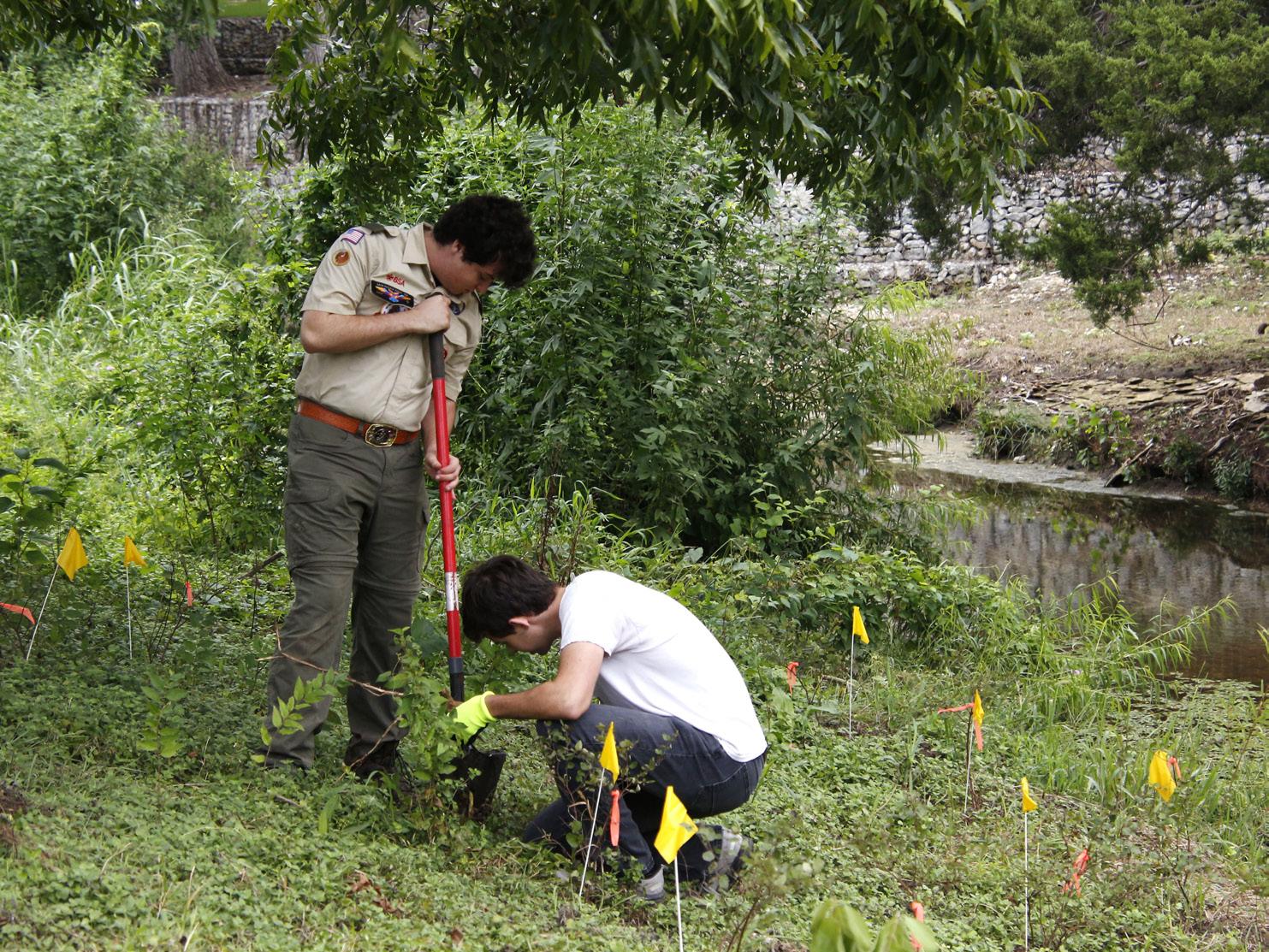
understanding of how to effect change by going through proper channels, proper protocols and communication with authorities,” Colvin said. “You can’t just go out and just stick stuff in the ground.”
Despite the challenges of legal issues, Newman sees the possibility of his project having an enduring impact on Greenhill. He envisions an outdoor classroom where students can connect with nature. Pollom and other teachers are also anticipating
Tthese spaces.
“A lot of teachers have wanted to use the creek for students and what Miles is initiating is to restore it to its proper way of being,” Pollom said.
Newman also says he hopes his project will spark inspiration and empowerment for future students.
“Fifth grade Miles was my dreamer,” Pollom said. “Now, he has a voice, and he knows he can put his dreams into action.”
Ladies Take the Lead in Student Council
his year marks a milestone for the Upper School Student Council, as all executive members of the group identify as female.
This is the only time in recent memory this has happened, according to former Upper School Dean of Students Jack Oros, whose institutional knowledge of the Student Council spans decades.
Every junior class officer is also female, further changing the prevailing perspectives within the Student Council. The immediate impact has been an increase in conversations about representation across the Greenhill community.
Road to Leadership
For many of these student leaders, the path to Student Council wasn’t
straightforward.
Junior Vice President Sidrah Tarpeh says that perseverance has been a defining part of her journey. After losing two campaigns to become class president, Tarpeh says her mother’s encouragement pushed her to keep trying.
Senior Hazel Goes-Young, who leads the work of the Student Council as the incumbent student body president, also had her share of setbacks.
“I lost when I ran for vice president my freshman year,” Goes-Young said. “Then when I ran again junior year and got elected as vice president, I was like ‘why not shoot for the stars and run for student body president.’”
The Greenhill Student Council is made up of both student body officers and class officers. The student body officers –president, vice president and secretary –oversee all four grades of the Upper School and lead initiatives that affect the entire

school community.
Class officers focus on their individual grade level, with each class electing a president, vice president and secretary to plan grade-specific events and advocate for their peers.
This year, Greenhill also introduced the Student Activities Board, a new group that works alongside the Student Council to plan school events and boost school spirit.
Goes-Young says that while leading has been an extremely rewarding experience, it came with certain gendered expectations.
“As a girl I feel like sometimes I have to give in to more of my funny side, so I’m not seen as too serious or too mean,” Goes-Young said.
Tarpeh says there was some quiet resistance when the new executive officers were elected.

“Last year I heard some little whispers and digs from other students against the new student body leadership when they were elected,” Tarpeh said. “We’ve been used to men being in these positions for so long, but I think people are definitely warming up to everything.”
Representation
While the shift to an all-female leadership group on the executive level has been significant, both students and faculty agree it wasn’t necessarily a planned outcome.
“I think it did happen by chance,” Upper School Dean of Student Life Kira Rivera
said. “Because in each position besides the secretary position it was a girl and a guy running against each other.”
Intentional or not, the result is an exciting new chapter for Greenhill’s Student Council, according to Student Body Vice President Kendall Johnson. For her, this change is about turning representation into action.
“What motivated me to run for student body vice president was that I wanted to be someone to spearhead the changes happening in our community,” said Johnson. “It’s about making sure every student’s voice is heard and that we’re creating a community that everyone feels included in.”
Tarpeh says she hopes the Student Council can inspire female students throughout the school.
“It’s important for freshmen and even girls in middle school to realize they can be a leader too, no matter what you look like,” Tarpeh said.
She added that even small moments, like younger students watching student leaders speak at assemblies, can have a lasting impact by normalizing female voices in positions of authority.
Rivera emphasized the importance of representation in leadership, noting that diverse leaders bring a wider range of ideas and experiences when making decisions. When students see themselves reflected in clubs, boards and sports teams, they are more likely to feel their voices are heard.
“I think in an ideal world we have everyone represented in leadership positions,” Rivera said. “Because then everyone has a voice if everyone’s being represented.”
Middle School
MS Football Key to Rebuild
Marleigh Massoud with Lily Schanbaum and Zayla Yousuf
As Greenhill Middle School athletes for their fall seasons, the seventh and eighth grade football team carries the expectations of a program dreaming of future success.
In Texas, a winning football team is a benchmark of a school’s performance. The sport creates a unique atmosphere for school spirit across the Lonestar State, according to native Texans.
Associate Head of School for Mission, Community and Culture Tom Perryman ’81 sees tremendous value in football’s potential for promoting the school’s values and sense of community.
“There is no single time on this campus that more people come together from all different ages,” said Perryman. “In terms of the impact on the community, football is just different.”
Steppingstone
Perryman experienced firsthand the impact of a successful football program as a Greenhill student in the 1970s.
“As a little boy, I could not wait to get to seventh grade and be able to put on a helmet with a ‘G’ on it,” Perryman said. “It was just this sort of beacon out there that you were just excited to get to do. I don’t think that has changed.”
After experiencing on-field success during Perryman’s years as a student, the Hornet high school football program dropped down the Southwest Preparatory Conference standings as other schools fielded bigger, stronger and faster squads.
The 2023 hiring of KJ Williams, a highly regarded collegiate and high school football in Texas, has inspired high hopes of a more competitive Greenhill program.
An important steppingstone to future Hornet success at the high school level is the Middle School football program.
The Long Game
The Middle School team is led by Coach Jaron Burgess. The team started the 2025 season on a high note with a 16-0 victory over Prince of Peace School. The team lost its second

game to Good Shepherd Episcopal School by a 26-6 score.
“They did better than we thought they were gonna do with the short amount of practice time that we had before our first game,” Burgess said following the season opener.

But the Greenhill Middle School team is young, and they ran into a challenging opponent in the second game.
With 23 seventh graders, the Middle School football coaches hope to build a successful program that will extend into high school.
“We’ve got a lot of young guys, so that means they’re gonna get a lot of reps, and ultimately, hopefully, those reps lead into creating better football players, more experience, more wins,” said Burgess. “There’s a handful of kids that that can contribute to our varsity team in the future if they continue to keep playing. They’re young, they’re hungry, they love the game, and that makes a difference.”
One of those players is eighth grader Sloan Shea. He credits the team’s growth to the consistency in their training and the determination of coaches to push them to do their best, on and off the field.
“We’ve got a lot of young guys, so that means they’re gonna get a lot of reps, and ultimately, hopefully, those reps lead into creating better football players, more experience, more wins.”
“I’ve learned how to be part of a team,” said Shea. “It teaches me hard work, determination.”
From his work with the Middle School team, Burgess expresses optimism about the football future at Greenhill.
“All the other stuff will work itself out, but if you have a great attitude and great effort, it’s going to help you long term,” said Burgess. “Greenhill is going uphill.”
Students Tour Japan and South Korea
Aashi Punnam with Sammar Agha and Laura Zaballa
Greenhill Middle School students traveled to South Korea and Japan this past summer as part of the school’s international summer program.
The two-week trip gave students a chance to experience life in a different part of the world and to learn how to navigate unfamiliar environments independently.
Led by Middle School history teacher James Herman, the group explored several cities, including Seoul, Busan and Tokyo. Along with sightseeing, the trip emphasized personal responsibility and cultural awareness.
“One of our main goals was to build independence,” Herman said. “We’d give them 30 minutes to go out and
explore a town. They’d meet us back after the time was over.”
In larger cities, students moved through public spaces like train stations in small faculty-led groups. In quieter towns, the faculty chaperones allowed more freedom, encouraging students to explore nearby streets, stores and local attractions on their own.
Eighth grader Layla Sherry says navigating the airport on the first day was both exciting and confusing.
“Everything was in a different language,” Sherry said. “We used Google Translate to figure it out. It was a little overwhelming, but also fun.”
The group visited palaces, shrines and cultural sites. In some locations, students were expected to follow local customs, like removing shoes or remaining quiet inside temples. They also had opportunities to meet local students.
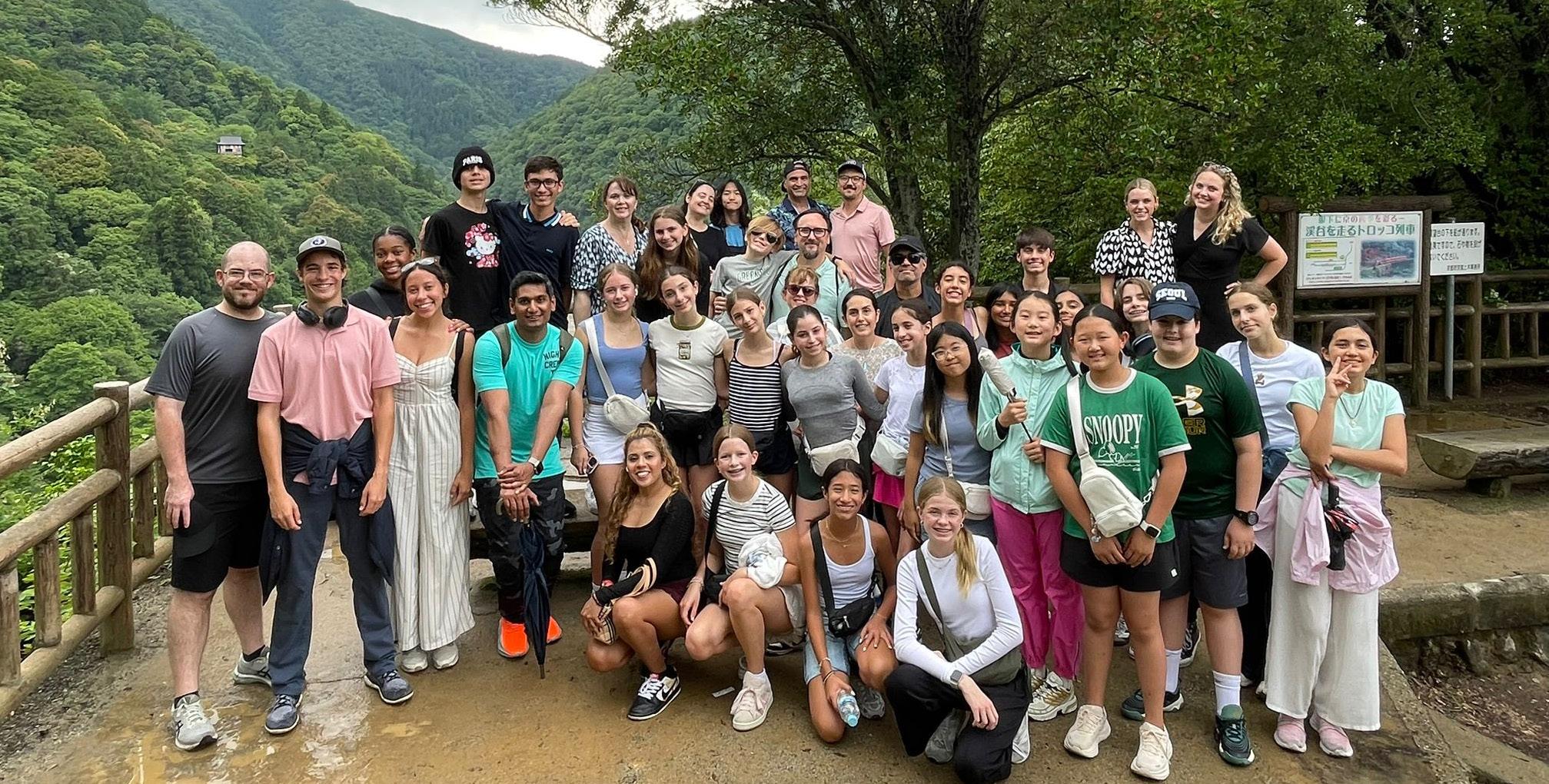
At one park in Japan, Greenhill students played games with elementary students on a field trip.
“We obviously couldn’t communicate because of the language barrier,” Sherry said. “But we’d play ‘rock, paper, scissors’ with each other, wave and high-five.”

Students traveled with a general itinerary but made many spontaneous decisions on the ground. In one case, faculty gave students a choice between shopping downtown or hiking a mountain to see monkeys. Herman said students navigated the decision thoughtfully, with some choosing to shop and others opting for the hike.
“They were willing to break out of their friend groups,” Herman said. “They shared their stories later and supported each other’s choices.”
Food was another key part of the trip. Students tried local street food and visited convenience stores near their hotels. Sherry’s favorite dish was a carbonara-flavored pack of Buldak instant ramen, which she bought and cooked in her hotel room.
Shopping was also popular. Students brought back gifts for family and friends, including magnets, snacks and small trinkets.
“When we asked what their favorite part was, I expected them to say the food or souvenirs,” Herman said. “But again and again, they said independence.”
For Herman, the trip held personal meaning. He had visited Japan and South Korea as a student and returned this year as a teacher.
“I walked a street I hadn’t seen since I was 18,” Herman said. “Now I’m 36. It was the same shops, the same signs.”
As students returned home, the lessons they learned extended beyond geography and culture. For many, it was the first time they made daily decisions without their parents or familiar surroundings.
“They saw the value of shared experiences,” Herman said. “And they learned what it means to figure things out on their own.”
Senior Brunch
Snooze an A.M. Eatery: A Familiar Sunday
Evergreen Senior Staff
Brunch at Snooze A.M. Eatery was a great idea. In hindsight, however, we need to plan our senior editor outings months in advance.
We knew that some of us were going to be absent when Vedant succumbed to a mysterious illness infecting Greenhill. Justin begged off for an important meeting. NoShow John? Who knows where he was.
Only four of us – Kate, Nora, Ella and Lylah – were present. Nora played the role of DoorDash driver for Sasha while John, Justin and Vedant visited Snooze on their own time. Here were our various experiences:
Since Snooze doesn’t take reservations, I arrived 20 minutes early to ensure there would be sufficient seating for what was

supposed to be seven of us. To ease my resulting “hangriness,” I ordered the sweetest dish possible: mascarpone-stuffed French toast topped with vanilla cream, caramel, strawberries and toasted coconut. OMG! indeed. But the real MVP was the sausage patty I ordered. Who knew sausage could be so good?
I started off with a vanilla latte. It was good, but nothing to call home about. The Sweet Potato Veggie Smash Up was the real star of the show. It was everything I wanted: something fresh and healthy but also slightly sweet. I was initially apprehensive about the Sriracha maple syrup, but it ended up being the perfect touch. I have no regrets and would get it again.
Four summative assignments in one week meant I was absent from the festivities again. Nora was my hero and delivered pancakes to my house. By the 11:30 a.m. delivery, it was already my “second brekky” of the day. Although I was only able to finish one pancake, I ate the other the next day. The flapjacks were nicely cooked – not overdone, but not raw either. The butter had soaked into the spongy carb goodness, and the sweet syrup added a separation from the saltiness.
I ordered the egg white scramble with asparagus, mushrooms, and tomatoes, along with a buttermilk pancake. I started with a
bland forkful of the eggs, but hope returned when I spotted sambal chili paste that elevated my culinary snooze of a scramble to a savory entree. My dessert pancake didn’t disappoint. I savored each crisp bite as it gave way to a moist cake interior. The sweet indulgence perfectly rewarded my egg white scramble discipline.
First, I got the matcha. It was the perfect color and the taste was well-balanced. For my brunch, I got blueberry pancakes and a chicken sausage on the side. I love any type of blueberry pancakes, but these exceeded my expectations. I was pretty full and didn’t finish my sausage, but the three bites I had were nice and salty.
Half-asleep and groggy on a Sunday morning, I was expecting a lot from Snooze. Their Juan’s Breakfast Tacos delivered. The green chile hollandaise complemented the runny scrambled eggs. The hash browns were a nice touch, adding a necessary crunch. The star of the dish? The salsa ranchera on the side. Overall, I enjoyed my Sunday morning tacos, though I wish they were a little less soggy.
I always love good French toast. Snooze’s wasn’t an exception. It almost perfectly blended the taste of hearty, sweet toast with the toppings of mascarpone, strawberry and coconut, which made it a delight in my mouth. My one critique is that the French

toast was, at times, overwhelmingly sweet. Overall, it was a great meal. I would come back again with my family.
I slept straight through the planned breakfast at Snooze, making it the second missed outing in a row. To make up for it, I headed there solo during my free period. I ordered breakfast tacos with bacon crumbs on top. With a little Cholula Hot Sauce, my tacos were a perfect combination of soft, fluffy eggs and crunchy bacon. When I laced up for my football game later, I felt the boost those tacos gave me that morning.

The Evergreen Crossword
Tej Dhingra ’21
When Tej Dhingra ’21 saw children struggling to learn at Addison’s George H.W. Bush Elementary School in his sophomore year, he combined his passion for service and business by starting a reading club that allowed Greenhill Upper Schoolers to mentor Bush students.
These days, Dhingra has channeled that same spirit of service into a Fulbright Scholarship, teaching English to high school students in Vietnam. As Dhingra embarks on a year of teaching in Vietnam, memories of his Bush Elementary students have remained with him.
“Seeing how so many of my friends in Greenhill joined that club really stuck with me,” said Dhingra. “It made me realize that it is very fulfilling to work with each student and help them gain confidence.”
Greenhill Memories
Dhingra’s interests in community service, learning and sports began during his time at Greenhill.
Entering the school in first grade, Dhingra was a very active member of campus. Upper School history teacher Scott Cotton remembers Dhingra as “serious, extremely hard working and curious.”
Dhingra says his passions were especially cultivated by Lower School teacher Laura Flanagan in his fourth-grade homeroom.
Flanagan remembers how Dhingra threw himself into studies of American history. In reading and writing assignments, he showed how prolific his knowledge truly was, Flanagan recalled.
“He was great at working independently, but he was also great at working in partnerships,” said Flanagan. “Because he had such an enthusiasm for learning, it just made the experiences for everyone in the classroom better because of his excitement.”
As he went into Middle School, Dhingra says his continued love for reading and learning led him to start a website called Teen Book Lover.
“I would have my friends write book reviews and publish them,” said Dhingra. “It was my first experience starting something on my own.”
In Upper School, he joined the Community Service Board and collaborated with former Director of Service Angela Woodson to start Bush Reading Buddies.
Every Wednesday morning, the organization would head to the Bush Elementary School and pair up with fourth grade students there to practice reading.
Dhingra’s presence was also felt on campus through sports. In all four years in high school, he was a member of the boys varsity tennis team. He said he learned a lot about how to work hard from Cotton.
“He would always emphasize the importance of having consistent routines,” Dhingra said. “I carry that with me now by breaking down any big goals I have into a step-by-step plan.”
Cotton says he remembers Dhingra having a large impact on team morale.
“I don’t think it really mattered to him if he played singles or doubles, or what number he played in the lineup,” said Cotton. “He was one of those guys that you could put anywhere in the lineup, and he would have given 100% effort.”
Pursuing Business
After graduating from Greenhill, Dhingra majored in economics at Bowdoin College in Maine.
In his freshman summer, he interned at a venture capital fund called Techstars and invested in sports tech companies. Dhingra continued to play recreational tennis on a club team throughout college.
“I learned a lot about how sports can be a really big uplifter for people,” said Dhingra.
In his sophomore year, he began a startup based on this idea and his own identity as a Sikh Indian. This company was called TAJ, which means “crown” in Punjabi. The organization was built through an Innovation Fellows program with Sikh American Legal Defense and Education Fund, and its goal was to create athletic
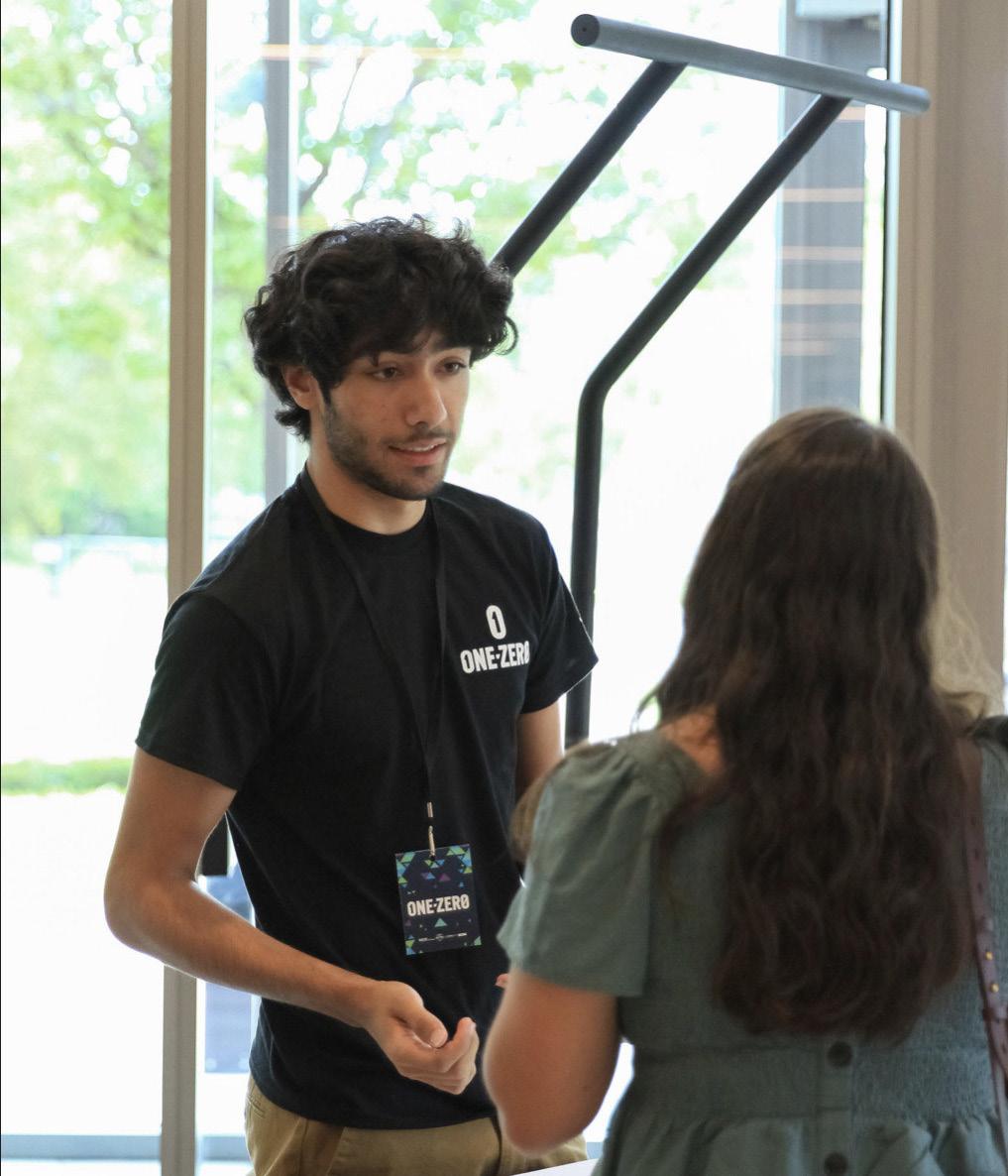

turbans for Sikh athletes.
The Innovation Fellows program at the fund provides aspiring Sikh American entrepreneurs the opportunity to develop their products professionally using breakthrough technologies produced from federal laboratories and academic research centers, according to the group’s website.
“It was a really great experience because it was more structured through this fellowship with SALDEF, the largest Sikh non-profit,” said Dhingra. “It really gave me some reps in learning how to manage a startup.”
In his junior summer, Dhingra joined Bain & Company as an associate consultant intern and received an offer to begin working there after graduation. Despite gaining experience in business, he missed opportunities to give back to other people, Dhingra said.
“It seemed like I could just coast through my senior year of college since I got a job,” said Dhingra. “But I realized that I lost that spark I always got in working with students at Bush Elementary and empowering youth. I really missed it.”
Teaching in Vietnam
While also applying for business school, his desire for teaching opportunities led him to apply for the Fulbright Scholarship. Named for the late U.S. Senator J. William Fulbright, a guiding force in international affairs following World War II, the program is a U.S. government-funded exchange program that gives American students the chance to live and teach abroad.
“Fulbright came up because it was a chance to combine that passion of teaching with a chance to show people the American story,” said Dhingra. “I was intrigued by the chance to be the first American that students met.”
After several interviews with the U.S.
Embassy in Hanoi, Dhingra was awarded the chance to teach English to students in Vietnam for the 2025-2026 school year.
Now, Dhingra is in his first few weeks working as a member of the English Department at Bao Loc High School for the Gifted, which is 125 miles northeast of Ho Chi Minh City. He says that he has decided to incorporate interests from his time at Greenhill into the program.
“With Fulbright, you are able to design some projects outside the classroom to help with the students,” said Dhingra. “I’m trying to center mine around sports as a universal language to increase confidence in my students.”
Though he has only recently started, Dhingra said in a recent Zoom interview that he is excited to experience new things in the coming year.
“It’s a really big challenge because I’m teaching in a pretty rural part of Southern Vietnam,” said Dhingra. “It’s definitely a big culture shock, and I don’t think I would have had the confidence to do it if Greenhill didn’t show me how rewarding it is to put yourself out there.”
Future Plans
Dhingra plans to work as a consultant at Bain & Company after his time in Vietnam. Beyond that, he wants to attend Harvard Business School. He has a deferred admission spot that will allow him to attend the school anytime within the next four years.
Despite not knowing what the future holds, Dhingra says he plans to continue following business in the fields he has grown to love.
“I’m very much of a ‘go with my gut’ kind of person,” Dhingra said. “But I would say it definitely needs to be in a space where I’m continuing to empower youth through sports or education.”
Karin Thomas
Lylah Pouratian, Ella Sadka
Karin Thomas, Ph.D., has spent the past 12 years at Greenhill as an Upper School English teacher and, since 2023, also serves as the Upper School English and Language Arts Department chair. Outside of the English pod, she enjoys Pilates classes, the outdoors and spending quality time with family.
6:30 A.M.

I ignore my alarm in the morning. My pets greet me to begin my day. I take my dog on a walk every morning. Sometimes I’ll see crows, herons, turtles and bunnies. This morning, I saw an armadillo. I believe that we should find joy in the things we do every
8:20 A.M.
On the way to work, I come up with the starting activity for each of my classes to help my students train their brains before we get into the day’s content. We usually do something focused like a drawing activity. Brain health is just as important as warming up to play a sport. When I get to school, I like to have time for mindfulness. It gives me a break before I start my day.
1:15 P.M.

8:50 A.M.

My Gold days are my elective days. My E Block is Women’s Literature. We are beginning with exploring definitions. One of the big questions we have been asking is “what do we mean by gender?” and then asking more detailed questions. People think literature is just reading a book, but sometimes it’s thinking about the book, or noticing differences in vocabulary.
10:20 A.M.
The second block of the day for me is a free block. As an English department, we do check-ins and talk with students. We also talk about our teaching and how our classes went. It’s like a tune up, it’s not formal. Part of education is building social relationships, so my pod is always open to have conversations.
11:50 A.M.
In Creative Writing, we are working on storyboarding. Our work is based off a cartoonist, Ivan Brunetti, and he believes that anyone can draw and everyone can tell a story. We spend this class finding different ways to tell stories using different mediums and mixing fiction, nonfiction and poetry.
I like to sit [at lunch] with other teachers from different departments. I love it when people just joke and find humor and tell funny stories. It’s a nice break from work. My
During Hornet Block, I do work but what usually happens is people come and check in during that block. There is usually a student that comes in or sometimes alumni. Teaching [the material] is such a small part of my job. It’s about teaching people how to be better human beings and to enjoy their days and lives.
4:30 P.M.
After I get home from work, I try to do some kind of fitness activity that challenges my balance and flexibility. I have been doing yoga since I was 19.
7:00 P.M.
My favorite dinner is when my daughter cooks. She’s like a chef. I’ve never been the greatest cook, but I’ve always had wonderful people in my life cook for me. After that, I usually talk to my mother or my daughter. I talk to them every day.
8:00 P.M.
I do another nature walk with my dog. It is usually in the evening, and I try to catch the sunset.

9:15 P.M.
I read about five books at a time, so before I go to sleep, I pick up one of them. If I am not in bed by 10:15, I do not have much energy the next day, so that is the latest my bedtime gets.
Evergreen Comic
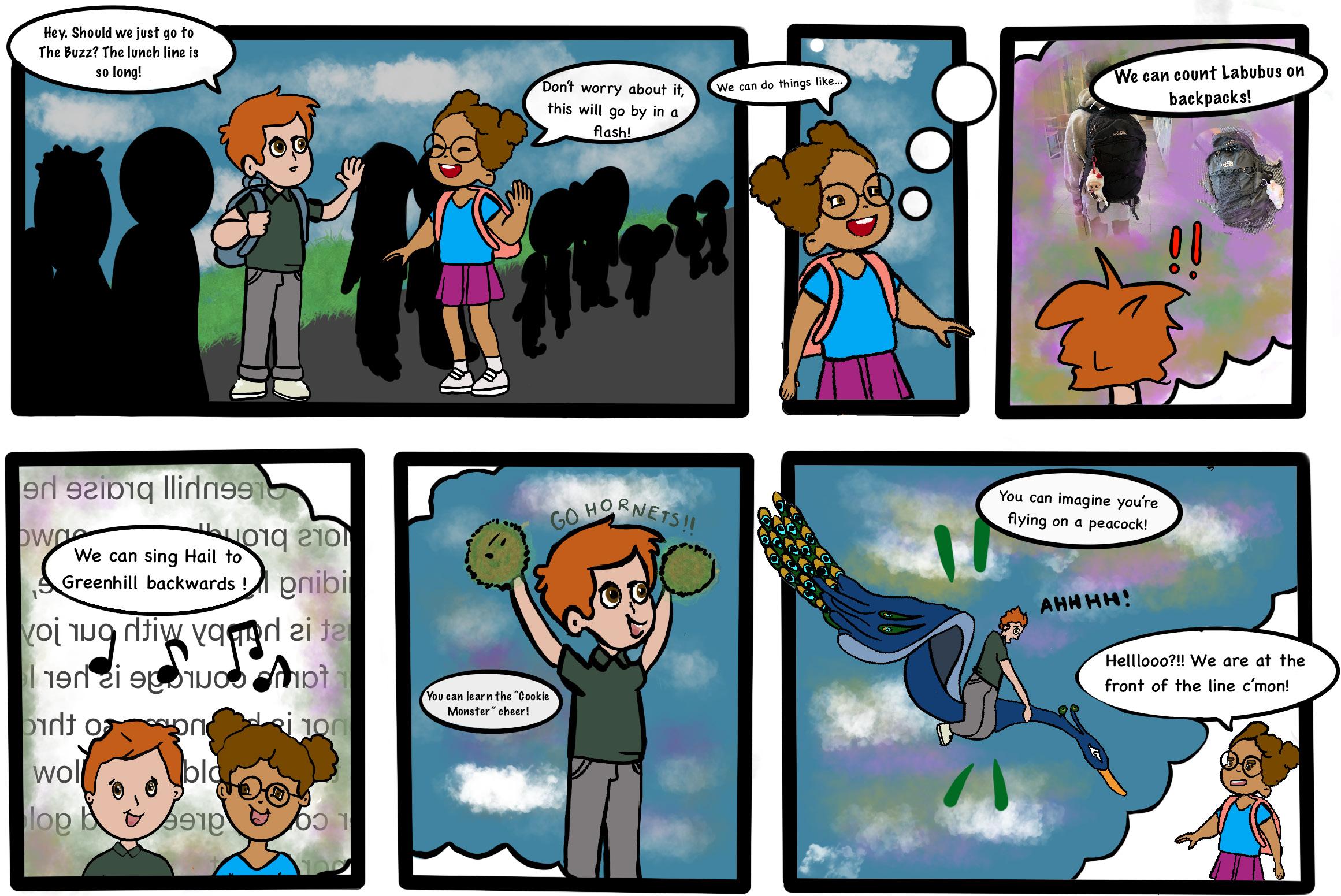
Cindy Chou
When Sadie Beck sat in a classroom tutoring English as a Second Language students, she says she saw looks of confusion in their eyes. A summer program abroad in Spain left her with the same feeling: lost in translation.
This connection sparked an idea that would grow into Bilingual Bookshelf, a nonprofit dedicated to providing bilingual literacy for children learning English.
“I realized my students feel like this on an everyday basis,” Beck said. “It must be really difficult.”
Inspiration
Beck says her inspiration for the nonprofit stemmed from her experience volunteering as a tutor for Spanish-speaking ESL students. As a tutor, she noticed how students were falling behind because they couldn’t understand the instructions for each assignment.
“I was able to see firsthand how those children struggled and what resources they needed,” Beck said.
Beck says her inspiration was amplified when she went to the Putney Student Travel program in Spain to improve her speaking and comprehension skills for Advanced Placement Spanish.
what it is like to be in a community where you don’t speak the language,” Beck said.
Nonprofit Launch
Beck launched her nonprofit in her junior year in partnership with Ursuline Academy of Dallas senior Alexandra Diaz. The two met abroad in the Putney Student Travel program in Spain and decided to work together to help Spanish-speaking ESL students with English literacy.
“I wanted to work with Alexandra because she is completely fluent in Spanish, her first language,” Beck said. “Her connection to Brownsville and McAllen, border towns in Texas, was extremely helpful when working on outreach for Bilingual Bookshelf.”
Within the nonprofit, Beck filmed, edited and compiled videos in a software
Sadie Beck’s Mission
obstacles to overcome,” Beck said in an email. “We are both very involved in our [respective communities], so finding times that we were both available to meet was always a challenge, however we couldn’t have made Bilingual Bookshelf such a success without each other.”
Together, the two partnered with an app developer to create Bilingual Bookshelf Kids. The app is video-based and provides picture books read aloud by volunteers in both Spanish and English, said Beck.
“Our main project is helping these children by providing the videos of the children’s book, and the app we created allows us to do this,” Beck said.
Sophomore Andres Smolensky was exposed to Beck’s project as a volunteer at Bilingual Bookshelf.

“My experience during my immersion program in Spain further opened my eyes to
program that became the Bilingual Bookshelf app. The next challenge was to expand Bilingual Bookshelf’s reach.
“There have definitely been some
“I think the work I did reading books in English and Spanish helped English learners find patterns within both languages and also find similarities and differences,” Smolensky said. To raise awareness about the app, Beck says she spoke at a church in Brownsville and posted flyers around that community. She also placed QR codes in medical offices on devices with the app pre-loaded onto them so parents and kids could download the app.
“In the beginning, no one knew what type of impact we would ultimately be able to achieve,” Beck said in an email. “However, hearing the positive responses from the patients and doctors, and having large hospital chains show interest in Bilingual Bookshelf, has made us more confident.”

Making an Impact
On July 22, Beck and Diaz were interviewed on KRGV 5, a television station in the Lower Rio Grande Valley of South Texas, to talk about Bilingual Bookshelf.
“I was definitely scared for the interview as it was completely in Spanish,” Beck said. “I was so nervous, but I’m proud we were able to make it happen.”
Beck says she hopes to sustain the Bilingual Bookshelf organization in the years ahead.
“I would like to expand it to other communities, specifically wherever I end up going to college,” said Beck.
Greenhill Students Participate in JFS Internship
Seven Greenhill students volunteered at non-profits in the Dallas area over the summer through the Rabbi Gerald J. Klein High School Internship run by Jewish Family Service.
The students who participated in the program were: seniors Marcus Kim and Kate Ponnambalam; juniors Carys Diamond, Neve Felder, Brielle Kommer and Lylah Pouratian; and sophomore Katelyn Herlitz.
The Jewish Family Service internship program began in 2009, and honors the longtime rabbi of Temple Emanu-El in Dallas, who died in 2007. Most students learned of the opportunity through an email sent out by Director of College Counseling Jenny Fisher, but some already knew about it from their off-campus communities.
“I had always known about JFS, being Jewish myself, so I thought I might as well do it,” said Kommer.
The selected students went through multiple rounds of interviews. The first round was with Jewish Family Service employees and volunteers.
For the second round, the applicants attended an event where they met representatives from different agencies. Finally, they ranked their preferences for their agencies and the agencies ranked their preferences for interns.
I had always known about JFS, being Jewish myself, so I thought I might as well do it.”
“You have to do a bit of work [for the application] and it’s a lot of hours over the summer but it’s just so worth it,” said Herlitz.
After students were matched with their organization, they worked with them for
180 hours.
Kommer was selected for the JFS Marketing and Event internship. In that role, she helped organize the group’s rebrand, assisted with archiving projects and made posters and flyers.
Herlitz interned with the WesleyRankin Community Center, where she worked at a summer camp for underprivileged children. Herlitz said the experience helped her fully understand the importance of education.
“Even though it was considered a summer camp, we still did a lot of activities like science or reading or math,” said Herlitz.
Diamond worked with Equest, an organization that provides equine-assisted therapy through riding lessons and other programs to children and adults with disabilities.
“I met a lot of really nice kids who went through really difficult situations, and I think that gave me a new perspective to how different people live,” said Diamond.
Some of the interns say they loved their experience and want to keep volunteering with their organizations.
“You’re not allowed to reapply to do it but if I could, I definitely would,” said Kommer.
In addition to the service hours and awards gained through this experience, Kommer says she also gained real-life work experience.
“It was very beneficial, especially working with other people and learning how to schedule meetings and how to get things approved and checked over by everyone else,” said Kommer.
The internships concluded with a showcase where students shared their experiences.
“I thought the end-of-summer showcase was really great to go to because we were able to show all of the work we had completed,” said Kommer.

10 Arts
Hornets Named to Prestigious Debate Teams
John Hurley
Three Greenhill students have been selected for debate teams at the state and national level for the 2025-2026 school year.
Senior Sarah Koshy made the National Speech and Debate Association’s USA Debate team; sophomore Marleigh Massoud was selected for the association’s USA Debate Development team; and sophomore
Arhaan Iyer earned a spot on Team Texas, a statewide debate team chosen by the Texas Forensic Association.
These selections are specifically for World Schools Debate, the only international format that Greenhill competes in. In World Schools, teams of three to five competitors face off in arguing opposing sides of a predetermined topic. Three members per team deliver two eight-minute constructive speeches and close with a four-minute reply.
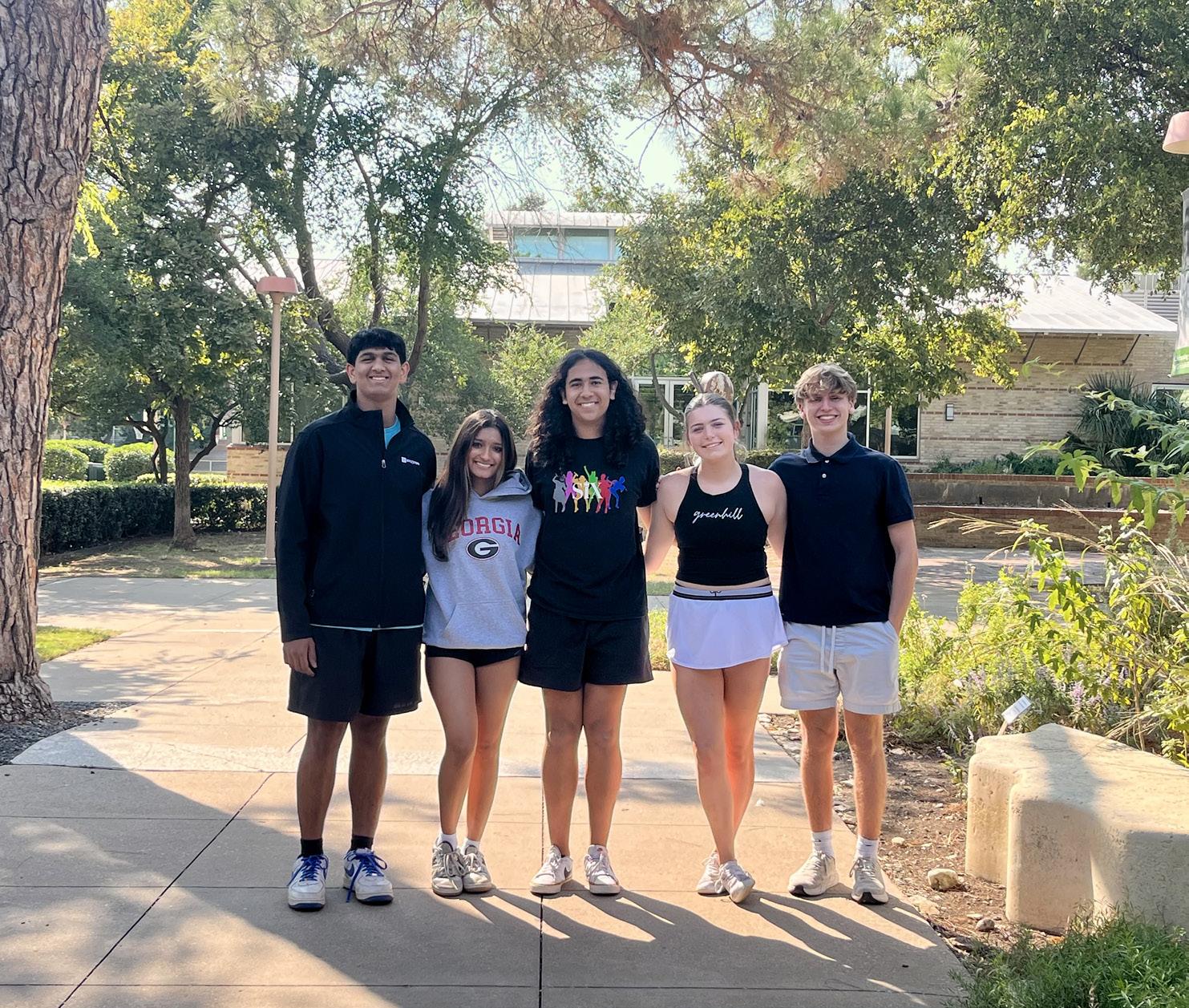
Photo by Naomi Wien
Senior Vijay Naidu, a member of the Greenhill debate program, noted that the momentum of these selections has inspired the school team.
“Seeing teammates make the [national and state] teams and succeed in national tournaments makes you want to push yourself,” Naidu said. “Even if you’re not at their level, you can see a path forward because at some point, you know they were in your shoes.”
Greenhill Director of Debate Aaron Timmons says National Speech and Debate Association judges made their 12 USA Debate team selections from nearly 200 applicants.
For those that didn’t make the final 12, the USA Debate Development team or Team Texas serve as a pipeline to prepare candidates for the national team.
Applications
Every year, a handful of Greenhill students apply for these teams. Several have been selected.
“When you’re coming up in the program as a novice debater, a lot of the seniors and alumni you look up to at Greenhill, who taught us much of what we know, were on Team Texas or Team USA,” Iyer said.
Koshy typically debates in the LincolnDouglas format. She said Timmons and assistant coaches encouraged her to apply for Team USA, despite the format being different from how she usually competes.
Naidu added that Greenhill fostered a strong culture around applications through their emphasis on peer mentorship.
“Everyone chips in,” Naidu said. “Even when I applied, I got help from several students that graduated last year.”
Goals
While the USA Team competes in primarily international competitions, Team Texas only participates in select national and international tournaments.
“A lot of [my goals] are making sure I put a lot of time and effort into the smaller tournaments so that we can break in those [more exclusive] tournaments like the Greenhill Fall Classic and Stanford,” Iyer said.

For Massoud, breaking into the top five of the national team is her top priority, which would allow her to compete internationally.
“I have two years left in high school, and by my senior year I want to be in that top five,” Massoud said.
Koshy has that same goal, which would allow her to represent the U.S. at the World Schools Debating Championships in Kenya next summer.
“Making that team, while balancing Lincoln-Douglas and World Schools [formats], and improving from last year is really important to me,” said Koshy.
Beyond trophies, Timmons says having Greenhill students debate at the highest levels has a broader impact on the 130-student Upper School program.
“Iron sharpens iron,” Timmons said. “What I mean by that is, if they’re debating against some of the best in the country and the best in the world at these different tournaments, they then bring that back.”
Music to Bridge Generations
Senior Aashna Saxena loves music and service. That’s how she and other members of the Greenhill Chamber Orchestra ended up volunteering at Legacy Senior Communities.
They began performing at Legacy’s Plano facility in March after Saxena had volunteered there on her own time.
“Music obviously has very widespread positive impacts, both in terms of cognition and emotional well-being,” Saxena said. “So, I really wanted to present the [Legacy residents] with those benefits, and I felt that our orchestra has a lot to offer.”
When Saxena presented this idea to her peers in the orchestra, there was a lot
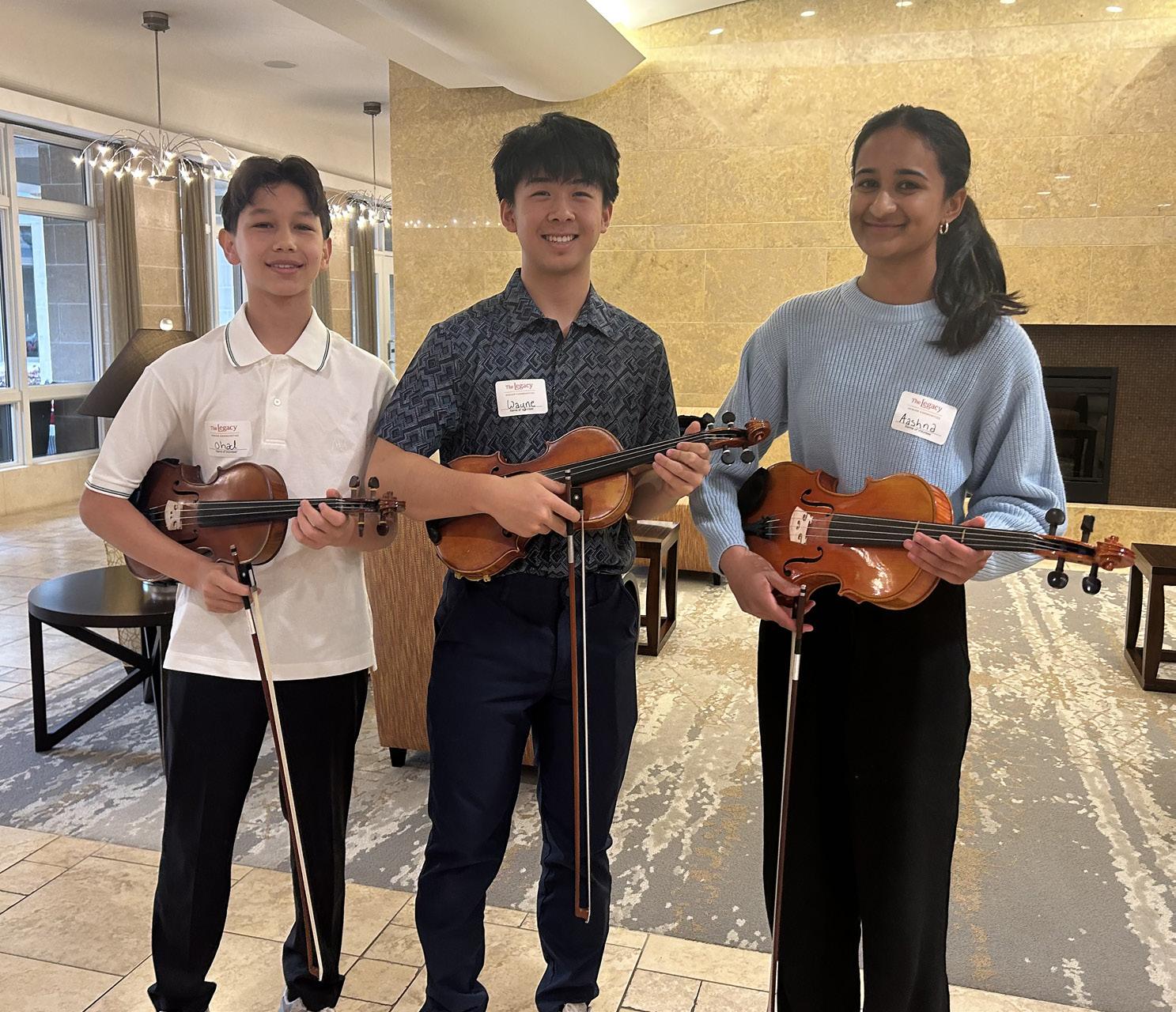
of excitement about the initiative, she said. Throughout the year, they coordinated rehearsals to prepare for half-hour performances.
Saxena received support from Upper and Middle School Orchestra Director Nick Paraskevas to organize the project.
“It takes a good sense of leadership and accountability from the leaders to do this because they have to make sure that the program runs smoothly,” Paraskevas said. “We have been blessed over the years to have a number of people that have taken on projects like this, and they’ve done it well. So, I’m super delighted that Aashna is also inspired to do this.”
Community Impact

After each performance, the Greenhill musicians converse with Legacy residents.
“I think it really benefits both communities in different ways,” Saxena said. “Playing music for the seniors and talking to them afterwards bridges the generational gap.”
Students say the Legacy residents shower them with compliments and share their own experiences with music.
“I think the most rewarding part was seeing all the people that reminisce on their old memories, whether some people used to play an instrument, or they had kids who played an instrument,” junior Soraya Sachdeva said.
The opportunity allows Greenhill students to utilize their musical skills outside of school and concert settings.
“I think it’s important for Greenhill students because it’s a nice way to actually give back to the community and realize that we can use our music in so many different ways other than in just an academic purpose,” Sachdeva said.
Future Outlook
Saxena is set to graduate next spring, but discussions on how to continue the project are already underway.
“What I like is that it’s not just her class peers who are involved, but that she has younger people participating too,” Paraskevas said. “That means there’s more of a chance of service through music continuing beyond this year. Aashna and her senior peers can look back and say, ‘I helped them get started.’”
Some younger participants envision broadening the impact of their musical talents.
“In the future, we should expand to other places other than this specific senior home,” sophomore Ohad Wong said. “Maybe we could play at hospitals, other elderly homes and just expand to different places so we can help more people be more joyous.”
Saxena says service in the form of art goes beyond the surface level by uniting people in a diverse way. It shows the larger power of performance, she said.
“Music is a very universal language,” Saxena said. “It really transcends barriers and bridges together communities that aren’t alike, and I just feel like music that we play [does] a good job of that.”
Greenhill Changes 2D Art Classes
stressful, and I feel like I’m producing art mechanically.’”
After years of offering Advanced Placement 2D Art and Design, the Upper School removed the course from the catalog this year, replacing it with Honors 2D Art and Design as an alternative highest-level art class.
Head of Fine Arts Terry Martin says this decision came when prior students revealed a desire for a more flexible curriculum, in contrast with the rigid nature of AP Art.
“Students felt that they couldn’t be self-expressive because they had to do specific projects for this AP class,” Martin said.
In AP Art, students are expected to develop a sustained inquiry, choosing a topic to base their artwork around throughout the course. At the end of the year, they must submit a portfolio of their artwork, captured in around 20 digital images and written statements.


Some students found the fast-paced nature of the course challenging and felt it prevented them from fully immersing themselves in their work.
“It was stressful because of all the deadlines, and we needed to have so many pieces done by the end of the year,” senior Laura Presley said. “I was like, ‘This is too
Senior Nina Kaplinsky, who took the course last year, disliked the constraints of sticking to one topic the whole year.
“I was drawing a lot of similar things all year,” Kaplinsky said. “I just wanted to switch it up and draw a landscape for fun or paint something fun.”
Martin cited this as one of the reasons the alternative course, Honors 2D Art and Design, was proposed.
“We were watching students feeling like they were limited by what AP was requiring them to do.” Martin said. “As artists ourselves, [fine arts instructors] began to ruminate about whether this is the best way for an artist to develop their voice.”
The idea to implement Honors 2D Art and Design was suggested a few years ago, and the final decision was made last fall. The course gives students more freedom and time to develop their work while still being challenging.
“Students
felt that they couldn’t be self-expressive because they had to do specific projects for this AP class.”
“Having a broader portfolio that represents their voices, more specifically than the projects AP set up, is beneficial in the long run,” said Martin. “In honors, the curriculum allows students to explore their
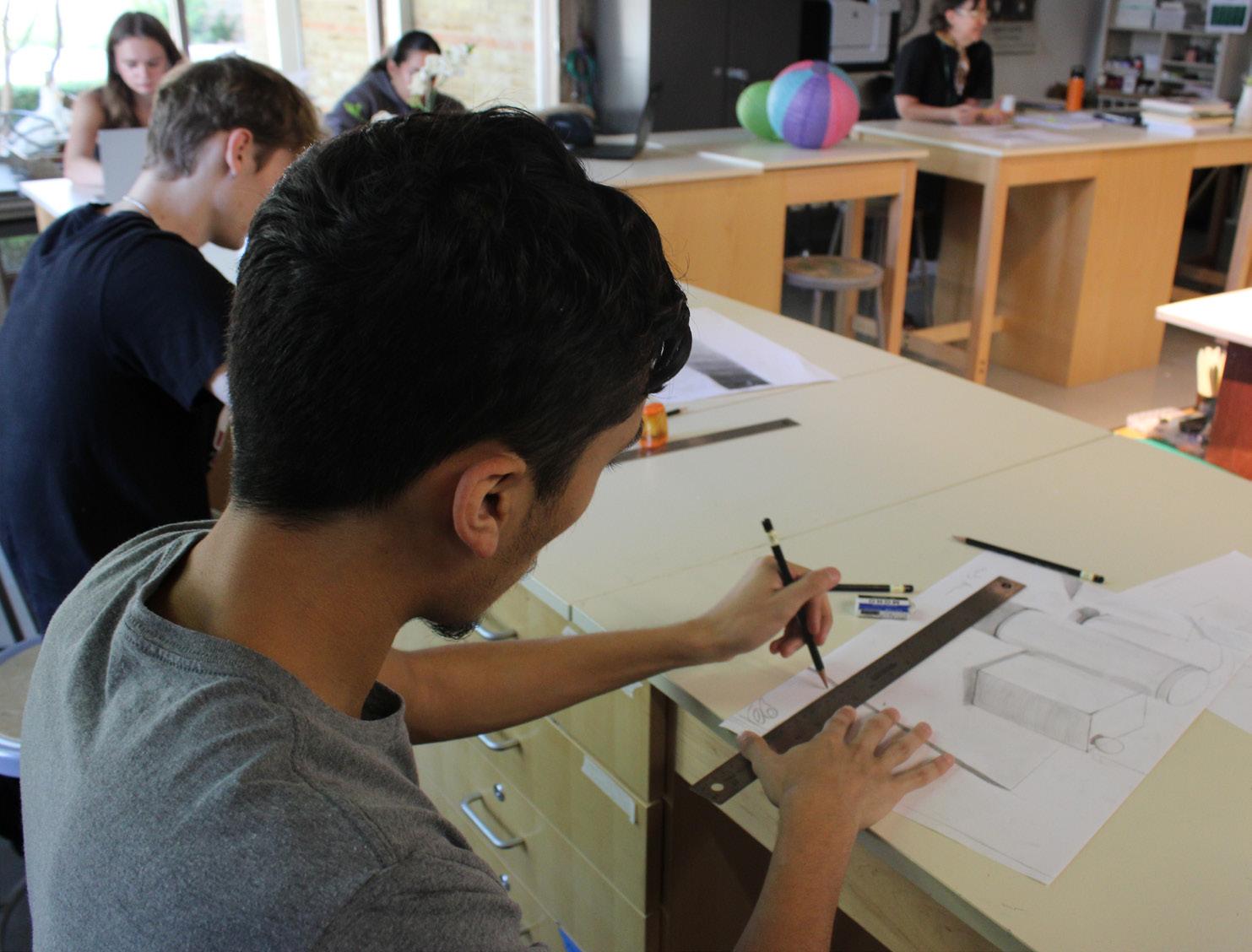
voice and build a broad portfolio; they’re not forced to do something that may not be their thing.”
Upper School 2D art teacher Kendall Davis says the new class is intended to provide students with the opportunity to explore different artists through field trips to museums and galleries, as well as more versatile projects than in AP Art.
“It’s still a very much self-driven, independent course,” Davis said. “I want them to try different things and develop their voice as an artist.”
Thus far, students have been given the
prompt of “identity” for their first project and taken a field trip to see a gallery in the Design District.
“Identity is a really broad topic, but you can take it in multiple directions,” Kaplinsky said.
Davis says she hopes the new course will allow students to be more exploratory with their artwork and feel more freedom in the class.
“I think they’re very excited and feel more empowered with risk-taking this year and really making mistakes,” Davis said.
Sabrina Carpenter’s “Man’s Best Friend”
brain just ain’t there,” Carpenter coos on the album’s lead single, “Manchild.” As a prologue, the song pushes a
Sabrina Carpenter is no stranger to controversy, and honestly, she seeks it. Even before the 2025 release of her album “Man’s Best Friend,” the singer had sparked a backlash by releasing the controversial cover photograph for the recording.
The image shows a faceless man in a suit pulling Carpenter’s hair while she is on hands and knees. Alongside the album’s title, her artistic choice suggests a self-portrayal of her as a dog, a very provocative metaphor.
“I do feel like submission is both dominant and submissive,” Carpenter told Interview Magazine.
While I support humor, this joke went too far. Some argued distaste for the cover highlighted naivete, but I believe the image displayed a lack of awareness for our current political climate.
Given the heightened attack on women’s rights, a cover depicting sexist imagery stings for many listeners. Even as a joke, danger arises from the misogynistic narrative it pushes and the positive affirmation it gives to some.
The album was released on Aug. 29, only a year after its predecessor, “Short n’ Sweet.” Carpenter’s wit and musicality became obvious through the 12 tracks of “Man’s Best Friend,” but so did the rushed production.
Remember that history essay you procrastinated on until the night before? Under-researched, but substantial enough to pass?
“Man’s Best Friend” reminds me of that.
“Never heard of self-care // Half your
falls back to Carpenter correcting her partners, mainly stressing the importance of responsibility. “You’re havin’ these epiphanies

“Don’t Worry I’ll Make You Worry,” also sounds choppy in this way. While the intro could be a vault track off Swift’s “Folklore,” her profane lyrics make it distinctively Carpenter. (In that vein, nine of the 12 tracks on “Man’s Best Friend” are rated “explicit.”)
My personal favorite, “When Did You Get Hot?” evokes Ariana Grande’s “Positions” with its sultry tone. The smooth, minor-key progression pushes a flirty feel, and I wish more of her songs embraced this playful mood.
Other tracks landed at just mediocre, like “Go Go Juice.” The redundant “10 a.m. o’clock” lyric captures drunk dialing but still feels sloppy. “House Tour” is also average, a B- at best. It seems ad-like, maybe hinting at a collaboration with Chips Ahoy, a brand she references in the song.
“Goodbye” serves as a fitting closer, but it is just ok. Sampling ABBA’s “Gimme! Gimme! Gimme!” the track is covered in its melodies. Carpenter’s use of foreign languages, such as “Arrivederci, au revoir,” is playful, not groundbreaking.
In many ways, this album feels rushed. None of the songs are necessarily bad, yet I’m not reaching for them in my daily Spotify sessions, unlike her 2022 album, “emails I can’t send.” The overwhelming reliance on past musical successes, like ABBA and Dolly Parton, only underscores the production’s In all, “Man’s Best Friend” was nothing special, lacking anything provocative enough to justify all the controversy.
Centerpiece
Consumerism and Self-Expression
Arbuckle, Aanya Bhoria, Khushi Punnam
It was another normal session of doomscrolling for Aiden White about four years ago when he came across a TikTok video that prompted him to buy a Stanley tumbler.
“I saw a video that said Stanleys are going to be the next trend and if you buy one right now, you’re going to get a jump on the next new thing,” said White, now a senior on track to graduate next spring.
Sure enough, Stanley tumblers exploded in popularity at Greenhill and across the country in 2023, giving White bragging rights.
“When everyone else got one I was like, ‘hmm, I’m better than y’all’ and I had this feeling of superiority because of the feeling I got when I bought it,” White said. “It felt like I was in on what was happening with the world.”
This sense of accomplishment for being in sync with the latest styles and pop culture trends compels many Greenhill students to walk around campus with whatever is fashionable at any given moment.
Greenhill has purposely avoided a dress code over the decades to allow student choice and expression – a policy that now aims to break gender-conforming standards and encourage individualism, according to Head of Upper School Trevor Worcester.
Yet, many students say online influencers touting the latest products and trends on TikTok and other platforms are increasingly eroding individualism and subtly pressuring teenagers to conform to the latest notions of what’s stylish and cool.
Senior Lily Marshall sums up the fear that nags at many students on campus.
“I feel like people have a negative [view] if you look too different from the norm,” Marshall said.
Digital Influence
Today, social media plays a prominent role in the lives of teenagers. From providing inspiration for fashion choices to allowing self-expression through posting content, its presence is undeniable.
“I think trends are definitely spread through social media, and what influencers are wearing or what’s being pushed through ads kind of determines what gets popular and gains traction,” Marshall said.
Although trendsetting is not a new occurrence, social media has changed how it happens. Before the presence of social media, many young people drew inspiration from magazines or television channels such as MTV.
“
I saw a video that Stanleys are going to be the next trend and if you buy one right now, you’re going to get a jump on the next new thing.”
While the fashion influence of celebrities and store catalogs from the 1980s to the early 2000s were very similar to social media’s influence today, there are key differences. They diverge in content advertisement, accessibility and the rate in which trends rise and fall, according to Director of Equity and Inclusion Monsie Muñoz ’05.
“Magazines would change once a month, so you weren’t seeing every single
trend the moment it happened,” Muñoz said. “I think in some ways, social media gives you access to a whole lot of information from all over the world at a moment’s notice, and there was nothing like that before.”
Unlimited access to a wide range of content allows some teens to find a suitable style that helps them authentically express themselves.
“I think that a lot of the students who have alternative styles find a lot of inspiration on TikTok and social media platforms,” White said.
“I feel like people have a negative [view] if you look too different from the norm.”
Trends also rise and fall more rapidly than in the past. Prior to the rise of social media platforms, trend cycles would last several years, taking time to gain traction and remaining popular for longer, according to The Vault, a fashion website.
From 2000 to 2015, clothing sales per person doubled while the number of times an item was worn decreased by 36%, according to a study done by the Ellen MacArthur Foundation.
Overconsumption has opened a pathway for specific consumer identities based on fleeting popularity. These identities are often called “aesthetics” and can be accompanied by their own list of associated products, values and personality traits.
Examples of these include “the clean girl aesthetic,” “coquette” and “the coastal cowgirl aesthetic.”
These personas are pushed by platforms such as TikTok and Instagram that use algorithms to enhance user experience. While this results in personalized content for each individual, algorithms typically push popular and branded content to the top of users’ feeds. Content can become homogenized, with the same styles and products being pushed.
TikTok’s recommendation system increases by 45% the chance of a video that has a high “like” ratio popping up on consumers’ feeds thereby causing the algorithm’s diversity of content to decrease because of trends, according to a study by Warwick Evans Publishing.
Worcester says students may feel that hopping onto trends will allow them to fit into a specific group or achieve a desirable lifestyle.
“I’m looking out right now at that table, and they all look similarly dressed,” Worcester said, referring to students seated at outdoor tables between the Upper School North and South buildings. “I wonder if students must feel compelled to conform in a way to be like others, as opposed to saying, ‘I’m just me and this is who I am.’”
Sophomore Essie Sagoe agreed.
“It’s like, ‘oh, I want that’ or ‘I want to get that. I want to be this person,’” Sagoe said.
Greenhill’s Policies
Through the loosely defined dress code, unique clubs, affinity groups, student spaces and leadership opportunities, Greenhill attempts to create a space where individuality can thrive.
“Students need a place to explore and then express,” Muñoz said.
Still, students often end up dressing and speaking similarly, a phenomenon that is amplified by social media. Trendy products
can often prompt students to create their own unofficial uniform.
“There is so much opportunity for self-expression at this school, yet students have a generally homogeneous approach to presenting themselves and I haven’t quite figured out why that is,” Upper School English teacher Andrew Mercurio said. Sagoe attributed the similarity among clothes to students drawing inspiration from one another’s outfits.
“For a lot of people I know, they look for clothing inspiration from what their friends or other students wear at school,” Sagoe said. “I’m like ‘oh that’s cute,’ I like how that looks. Let me go shop at the same brand.’”
While some students can tend to present themselves similarly, others take full advantage of Greenhill’s encouragement of self-expression.
“I wonder if students must feel compelled to conform in a way to be like others, as opposed to saying, ‘I’m just me and this is who I am.’”
“Obviously, there are a few outliers where people are afraid of what others might think, but for the most part kids at Greenhill do pretty much openly express themselves,” sophomore Dahlia Das said. When it comes to style, everyone has their own opinions on what they think looks good and what does not.
However, the Greenhill handbook emphasizes the importance of respecting one another, making the school a safe space for people to dress the way they want, at least in theory.
Despite this, there are mixed opinions on campus on whether students who fully express themselves are judged for what they wear.
White says some people judge the style choices of their peers, but not in a vocal way that harms others.
“I know some people here dress alternatively or dress in styles that I’m not a big fan of, but I’m never going to make fun of someone,” White said.
Das agrees.
“This school is a very accepting community as I have seen so far in the sense that people are able to openly express themselves without fear of comments from other people,” Das said.
“There is so much opportunity for self-expression at this school, yet students have a generally homogenous approach to presenting themselves and I haven’t quite figured out why that is.”
But no matter how hard a school tries to implement acceptable policies, it is common for teenagers to be critical of one another in today’s environment.
“Some people definitely judge other people for how they express themselves,” Sagoe said. “They probably won’t go up to their face and say like ‘oh that’s interesting,’ but they for sure will talk to their friends and judge them in that way.”
Several teachers and students say the fear of judgment among students is why most follow certain standards of dress. That’s how many students end up wearing the same
Self-Expression at Greenhill “
brands, following certain trends and having a comparable sense of style.
“I think safety and feeling like you can just be part of a crowd is more highly praised than having an individual look, because if you have an individual look that means people can judge you,” Upper School English and Language Arts Department Chair Karin Thomas said. even though there’s an invitation for students to try different things.”
Worcester added that students sometimes dress a certain way to appeal to their friends.
“There’s some unconscious need to feel like part of that group,” Worcester said.
Reflecting on her days as a student at Greenhill, Muñoz says that most people engage in some degree of social conformity.
“This pressure to fit in and follow what others are doing isn’t just a fashion choice, it’s a form of social survival and a lot of times it is an easy entry point to social circles,” Muñoz said. “I too felt pressured at times into having the same kind of outfit because I wanted to fit in.”
While external pressures will continue, some students express appreciation for Greenhill’s policies surrounding selfexpression.
“I think the school does a pretty good job with having no uniform and dress code,” Marshall said. “Those are, I think, both big things that allow people to express themselves now. As long as those two things stay in place, I think that the school is doing definitely more than most of our competitors.”
Students at Greenhill come from a diverse array of socioeconomic backgrounds. As a result, not every family can fund an expensive wardrobe or give students the full ability to express themselves.
In some cases, this can lead to students feeling like they do not compare to the average Greenhill student, Mercurio said.
“[Being on financial aid] can add a little bit to the imposter syndrome that kids of lower socioeconomic status might feel,” Mercurio said.
Worcester says he believes that private school privilege, not just at Greenhill but in the wider Dallas area, has played a significant role in how students who receive financial aid are able to express themselves.
“It’s got to be frustrating for those that feel they are not resourced enough,” Worcester said.
For students receiving financial help, the differences in socioeconomic backgrounds can affect who they are as a person, said a junior who asked to remain anonymous for privacy reasons.

“In a situation where people are raised with a lot of wealth, there’s a sort of bubble
following what other people do, and not always being yourself,” Glazer said. “It’s
I think safety and feeling like you can just be part of a crowd is more highly praised than having an individual look, because if you have an individual look that means people can judge you.”
person’s expression and their point of view,” Muñoz said.
14 Special Report Signal Blocked
Hornets Buzz Over New Phone Ban Policy
Lillian Smith, Sasha Wai
Upper School students returned to campus in August to confront the shock of a ban on the use of cell phones during school hours.
The policy aims to bring students together and encourage connections, according to Head of Upper School Trevor Worcester.
“Particularly [in the past] with the dining hall not open yet, and looking out
detentions to loss of technology privileges.
A student will receive an Honor Code violation for having a phone out at any point during an assessment.
Smooth Start
Thus far, Heinrichs and Worcester say student cooperation with the policy is going smoothly. Heinrichs says compliance has been enhanced by the statewide nature of
I will say just anecdotally, students [now] seem to be hanging out outside more and actually talking and engaging.”
members to help ensure a truly phone-free campus.

Upper School English teacher Andy Mercurio says he took note of Worcester’s charge.
“There were a lot of cheers that went out amongst Lower School and Middle School teachers,” Mercurio
implementation this fall, students are now experiencing what it’s like to live it.
I think the main reason for students to be on cell phones is the social aspect, and it’s one of those things where it’s hard for one student to put away their cell phone because they are literally going to be missing out on the conversation.”

When the state legislature moved towards [the policy] and passed it, it was like ‘Okay, if we’re not talking about it and figuring it out now, we’re now an outlier.’”
by Lydia Kerridge
For senior Owen Hanson, making music on the mobile version of GarageBand in third grade was his entry point into art.
In the 10 years since, his artistic talents have evolved and expanded to include photography, video production and, more recently, making musical scores for films.
The latest and most ambitious manifestation of Hanson’s passions is “Humaning,” his musical film-in-progress. At the same time, Hanson’s passion for composing scores has made him a key contributor in the Greenhill film program.
“There’s some people that direct their films and they want a very specific score, and I come in, and I don’t get much freedom,” Hanson said. “But I really love the ones where it’s kind of just, ‘Here’s my movie, do what you think is best.’”
Musical Journey
From making random sounds in GarageBand, Hanson started trying to recreate popular electronic dance music songs by watching YouTube tutorials.
“After I did a few of those, I was able to create my own music,” Hanson said. “They weren’t great quality. They were written by a fourth grader, but it was still fun to do.”
He then progressed to FL Studio, a popular digital audio workstation for creating music.
“I didn’t really know where to go from there, and so I actually ended up finding a summer camp that taught FL Studio to kids,” Hanson said.
Hanson credits playing ukulele and drums as an accelerator of his music composition progress.
“I think especially drums really helped with rhythm and counting music,” said Hanson. “I didn’t really learn from music composition. I learned from playing instruments.”
A free orchestral plug-in for FL Studio and a Hans Zimmer interview sparked his transition to scoring films.
“I thought that was really cool,” Hanson said. “From there, what I would do is take movie scenes with the music edited out, download them, and then I would just rescore it.”
Photography
Alongside the development of his new film, Hanson is involved in photography and video production at Greenhill.
Hanson started his photography journey as a freshman at St. Mark’s School
of Texas.
“My old school had a good photography program, and I really liked the teacher,” Hanson said.
When he came to Greenhill as a sophomore, Hanson said it would have felt weird to not continue photography. As a result, he joined Photography II.
“I had a couple friends in [the St. Mark’s photography class],” Hanson said. “The class was its own family. So, I wanted to see if Greenhill had that too, and it did.”
The photography program at Greenhill has more options than St. Mark’s, the most notable one was Greenhill’s first-rate darkroom, used to process light-sensitive film and images.
“At first, I didn’t do anything in the darkroom,” Hanson said. “But last year, especially, I really dove into more experimental darkroom stuff.”
One of the experimental techniques Hanson has worked in is Mordançage photography, a process in which acid alters the shadows of a darkroom print.
Using Mordançage, Hanson created “Veils of Duality,” a piece that won an Honorable Mention and $500 scholarship in the Young Dallas Artists Exhibition at the Blue Print Gallery.
“It was a photo of my good friend [senior Derian Herrmann] in an empty, under-construction, parking garage,” Hanson said. “You most likely wouldn’t be able to figure it out. It’s very abstract.”
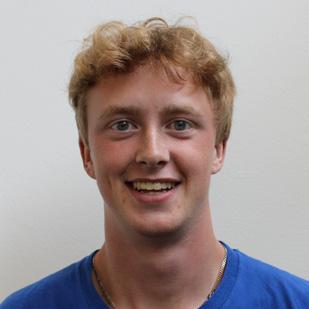
Hanson explained that his vision for the piece was born in Abstract and Experimental Photography, a summer course at Greenhill that emphasizes darkroom techniques.
“I felt a lot more confident that I can go and do that myself,” Hanson said. “Through experimenting in that class, I was able to use those techniques for images I took.”
School photography teacher
Frank Lopez says he witnessed Hanson’s growth and confidence in photography.
proficient in technique,” Lopez said. “He’s become a great experimenter in the darkroom, and his language has grown tremendously.”
says he enjoys the program at Greenhill because of its inclusive and lively environment.

Owen Hanson

“It’s fun because [Greenhill photography] is our own little family,” Hanson said.
Lopez says this family environment is nurtured through a culture that encourages people to share their ideas and others to listen to them.
“[Hanson] celebrates other students, he listens, and he’s willing to learn from other students as well,” said Lopez. “He’s very open to sharing his own knowledge.”
Film Scoring
finding opportunities to use that talent,” Gupta said.
Future Plans
These days Hanson is in the process of filming and composing the score for “Humaning.” Set in a large, open field, it centers around Jane, who believes something is wrong with a society others view as perfect, according to Hanson.

Doyle said. “And then anyone that asks him, ‘Hey, can you help me do music?’ he always says yes.”
Senior Syrus Gupta, who is in the AVP class, describes the energy that Hanson brings to his work. “He talks with a lot of passion and a lot of vigor,” Gupta said.
Through his work in the Greenhill film program, Hanson has positioned himself to pursue his passions after graduation.
“He’s found this niche of music for himself that he really wants to dedicate a lot of time to, and he’s always
The film stars juniors Elise Nelson and Josh Schnitzer and is directed by sophomore Desi Garza and Gupta.
Hanson says his inspiration for the film came from an Instagram Reel he thought was funny. He originally visualized “Humaning” as a regular film with music forming a background to dialogue and other sound effects, but the idea has
“The problem was that [the film] was all dialogue, and no one wants to write dialogue,” Hanson said. “And then I got the epiphany. What if instead of dialogue it was
Hanson says his work in photography and film scoring have impacted the development of the film.
“What it uses from photography is staying within the bounds of what you can actually accomplish,” Hanson said. “It was easy to find an open field [to film in]. There’s not a village we need to build.”
Hanson says he hopes to release “Humaning” in December, after filming is completed this month.
Looking beyond graduation next spring, Hanson says he hopes to continue his work scoring films, his preferred genre in music composition.
“It’s hard for me to find inspiration on my own, just to sit down and write a song,” Hanson said. “I’ll compose a theme to a couple characters, and then from there, it kind of whittles down into more of a score.”
In college, Hanson plans to major in music composition. Eventually, he would like to work professionally in the field.
“Hopefully, out of that, I’ll be able to score movies,” Hanson said. “Score movies, score TV shows, score video games. There’s a ton of different things you can do.”
Doyle says Hanson has the right mindset to achieve his goals.
“Owen is one of those people who reaches for the stars, and he doesn’t see limits,” Doyle said. “And the best artists don’t see limits.”
AVP Students Reel in Festival Success
Over the summer, two films by Upper School Advanced Video Production students were showcased around the country in film festivals.
“Seventh Heaven,” a film by seniors Syrus Gupta and Davis Knocke, was juried and screened at the Seattle International Film Festival in May. The film follows a high school student named Zain in his progressive loss of control between dream and reality.
The film’s critical and public reception has made Gupta and Knocke “two of the most impactful young filmmakers in the country today,” according to Corbin Doyle, who teaches video production classes in the Upper and Middle School and directs Greenhill’s film program.
with this thing I spent hundreds of hours on and I’m finally putting it out into the world, and it doesn’t scare me.’ It’s a really cool opportunity to show people what you’ve done.”
The Seattle festival where Gupta and Knocke’s film was featured is an 11-day event, attracting nearly 150,000 attendees who can vierw over 250 features, documentaries and short films from more than 70 countries and regions around the world. “Seventh Heaven” was one of 14 youth short films selected for the Seattle festival’s FutureWave category for students in the 13-21 age range.
“It was a really cool feeling, because you can be at home working on whatever you are, having school like a normal student and then your name is getting praise on the other side of America right now,” said Knocke. “The fact that it’s happening to something that [Gupta] and I came together and made is kind of unreal.”

Throughout the summer, the Gupta-Knocke film racked up awards at nine other festivals across North America: Pegasus, Cineyouth, AltFF, Atlanta High School, All American High School, Calgary International, Dallas International, Sidewalk and GTX film festival. The awards have included Best Overall Film, Best Visual Effects, Best Lighting and Best High School Experimental film.
Another film by Upper School students, “Tinkle,” a short created by Knocke, Andrew Hough, Tony Velazquez, Charlie Waldman and Derian Herrmann, was accepted into four film festivals: Flint Youth, Pegasus, Sidewalk and the All-American High School events. The film is about a nightmare between two brothers.
“[AVP students] are expected to put their films out into the world and the easiest way to do that is to submit them for film festivals,” Doyle said. “It’s a measurement of the impact of your film to other filmmakers and a chance to meet professionals.”
Submission Process
Students submit their films for festival consideration through Film Freeway, the world’s largest database and catalog of film festivals and screenplay contests. Students create a project profile for their film with a trailer, synopsis and director’s statement.
Next, the filmmakers research festivals they feel would highlight their project.
A film festival’s program includes an opening night, several days of screenings and Q&A sessions and a closing night. Some grant prestigious awards and thousands of dollars in scholarship money and equipment.
“There were moments I wanted to cry because of how people were reacting, the love that we were receiving from our friends,” said Knocke.
Beyond the benefits of viewing other creative work, Doyle says one of the best aspects of traveling to a film festival

“In the old days, research was word of mouth, and you might hear about festivals in North Texas and some in L.A. and that was it,” Doyle said. “With Film Freeway, you can filter for festivals around the world. One of my favorite festivals is in Berlin and it’s an all-women-produced horror film festival.”
The submission process is akin to “applying to colleges through the Common App,” according to Gupta.
“When I submit, I honestly just feel excited,” said Gupta. “It’s that moment where you’re like, ‘Wow, I’m really done
There’s a lot of the people that I met two to three years ago at the Dallas International Film Festival that I’m still close to today.”
Creative Process
The idea for “Seventh Heaven” was created by Gupta and Knocke during Greenhill’s 2024 summer video production camp. They spent two weeks brainstorming sequences and


scripts behind the Marshall Family Performing Arts Center stairwell, an area the two have nicknamed “the lab.” After seven months of shooting and editing, the film was finally ready for screening.
Production was not without its difficulties. Gupta and Knocke had to manage dozens of people as extras for their party scene and plan the logistics of filming around Dallas.

“As someone who also does film, I think one of the hardest things to account for during the process is image quality and lighting consistency,” said senior Chloe LaGrone. “I still remember the opening master shot and thinking ‘what kind of insane lighting setup did they do in a space with that many people around to get it lit that way?’”
For Gupta, one of his favorite things about the film is working with Knocke. He said the process has made him realize there is no such thing as perfection and that he was influenced by Knocke’s positive mentality on set.
“Working with [Knocke], I feel like I’ve been able to get so much farther with our work because he puts in equal effort,” said Gupta. “I learned how to compromise more, to enjoy the time we have on set and enjoy the experience.”
Waldman had a similar experience with “Tinkle,” explaining that the people he worked with on set made it one of his favorite shoots that he has ever worked on.

“You physically cannot create a film by yourself,” said Waldman. “For ‘Tinkle,’ me and five of my best friends were making a stupid film and we were all laughing to ourselves. It’s so cool that we can be telling stories and making art through this medium.”
For both films, the bulk of the production involved months of editing.
“We were such perfectionists, which made it feel like such a grueling process with no reward to it,” Knocke said. “The more we looked at it, the more we critiqued it because we wanted to be the best we knew it could be. Once it was done, we were finally able to come together and celebrate it.”
For the final round of editing for both films, AVP students came together with Greenhill alumni and Doyle to evaluate the work. When they were done, the room erupted in applause, according to Doyle.
“Seventh Heaven” had multiple showings on campus and one at Knocke’s house with over 40 people. The audience included family, friends and actors. Their main actor – a freshman at Pace University – and another actor they hired from Dallas came to watch the film and share their opinions, according to Knocke.
“It was really nice to see all our friends come out and support me and Syrus and hear from people how much the film meant to them,” Knocke said. “It’s an encapsulation of what AVP means – to go spend 10-plus hours on a friend’s set just because you love them and want them to succeed. That’s what this group of 40 peers was able to do for us. As a filmmaker, that’s what it’s all for. We will love and cherish this group forever, because we both know deep down that this film would have been impossible without them.”
Sports
Soccer Duo Goes D1
America,” Han said. “That final match was something I will never forget.”
Juniors Alex Han and Raelyn Young say they have made verbal commitments to play women’s soccer at the NCAA Division I level after they graduate from Greenhill.
Han says she has committed to the University of Virgina. Young says she is headed to the University of Texas at Austin.
Both athletes say soccer has been part of their lives for as long as they can remember. Han first started playing in kindergarten while living in Seattle.
“All the girls in my class were doing it, so I decided to join,” Han said. “I then joined a club team later the next year.”
After relocating to Dallas, Han joined D’feeters Kicks Soccer Club, where she first played with Young.
Young’s soccer journey began when she was three years old after spending time watching her older sister’s games.
“I ultimately got cultured into loving it,” Young said.
She worked her way through several clubs before crossing paths with Han. Two years after starting to play together at D’feeters in seventh grade, they transitioned to the Solar Soccer Club, a nationally recognized program that has since been central to Han’s and Young’s development.
They now play for Solar ’09 Girls in the Elite Clubs National League and also are going into their third year playing on the Greenhill girls soccer team.
Accomplishments
Han and Young have been able to translate their hard work into high levels of youth soccer success.
Han says her proudest achievement was playing in the 2024 Confederation of North, Central America and Caribbean Association Football Girls’ U-15 Championship. The two-week tournament featured the region’s highest-ranked national teams. Representing the United States, Han’s team ultimately defeated Mexico 3-0 in the final.
“It was a great opportunity to play against girls from all over North and Central
Young has also played in high-stake games. Competing at the Elite Clubs National League playoffs each year, she faces other top programs in the country.
“You really get into a competitive zone and have a lot of fun on the field,” Young said.
At the national tournament in Seattle, Young scored the winning goal in the last five minutes of the game that sent her team to Richmond, Va., to compete in the final four.
Recruiting Journey
Young says playing college soccer has been a long-term dream.
“The goal was always to play collegiately and get a good education while doing what I love,” said Young.
During nationals, Young witnessed over 300 college coaches watching the competition and scouting potential recruits.
“I just saw my future before me, watching the older girls play, commit and talk to the coaches during nationals,” Young said.
Han came to a similar realization during her freshman year after watching older club members commit to play collegiately.
“I saw girls from my club, not even that much older, starting to commit, and that’s when I realized it was a real possibility for me too,” Han said.
Han and Young have both immersed themselves in the recruiting process. Before NCAA Division I colleges could officially reach out on June 5, during the summer before their junior year, Han and Young spent months preparing by sending highlight reels, emailing coaches and demonstrating their skills at showcases.
follow through with the process.
When the calls finally began, the summer became a whirlwind of conversations, visits and decisions.
“It took up my whole life,” Han said. “It was very overwhelming because I didn’t truly know what to expect.”
Young echoes that these meetings were hard to balance with school life.
“There was no separation between school time and soccer time – it all just blended, and I had to fit in whatever I could,” Young added.
Behind the scenes, their families helped clip film, track schedules and keep everything organized. Still, the unpredictability of recruiting was challenging.
“There were schools where I thought I would get a call and didn’t,” Han said. “But there were also coaches who called that I had no idea they even knew who I was.”
Finding Their Fit
After countless emails, phone calls and visits, both players say they found the right match.

For Young, the decision took her by
“At first, I was convinced I wouldn’t go to school in Texas,” she said. “But when I visited UT, it felt cozy. Everyone was so sweet and welcoming, and meeting some of the girls on the team made it feel like home.”
She says the choice balanced academics, athletics and culture.
“Texas was a good fit all around,” Young said.
Han’s journey led her east, where the University of Virginia stood out immediately.
“I cared about three main things: the rigor of the soccer program, the rigor of academics and the location,” she said. “Charlottesville has mild weather, which was ideal for me.”
in the NCAA Division I Ratings Percentage Index for women’s soccer.
“I believe they can truly develop me as both a player and a person,” Han said.
Soccer Bond
A defining part of Han and Young’s journey has been the bond they’ve built along the way. As teammates for nearly five years, they have shared everything from carpooling to club practice to balancing demanding schoolwork.
“When I first moved to Dallas, Raelyn was the connection I had between my school and club soccer,” Han said. “She is the person I see most during the season, and it’s comforting to have that stability.”
Their chemistry is especially apparent on the field. Playing on the same side brings out the best in both, and they say their admiration for one another goes far beyond statistics or accolades.

“She is strong-minded and doesn’t let setbacks get to her,” Young said. “She is able to push through challenges.”
Young also recalls one of her favorite goals from last season, when Han dribbled past three defenders before crossing the ball perfectly for Young to score.
Han, in turn, says she looks up to Young’s grit.
“She’s fearless heading the ball, whether it’s on offense or defense, and she always rises up in big games,” Han said.
Girls soccer Head Coach Laura Flanagan, who played NCAA Division I soccer at Southern Methodist University, has witnessed the duo’s growth firsthand.
They say that Solar Soccer Club guided them through the process with meetings on statistics, coach communication and how to
The competitive environment at Virginia was another attractive feature, according to Han. In late September, UVA was ranked first
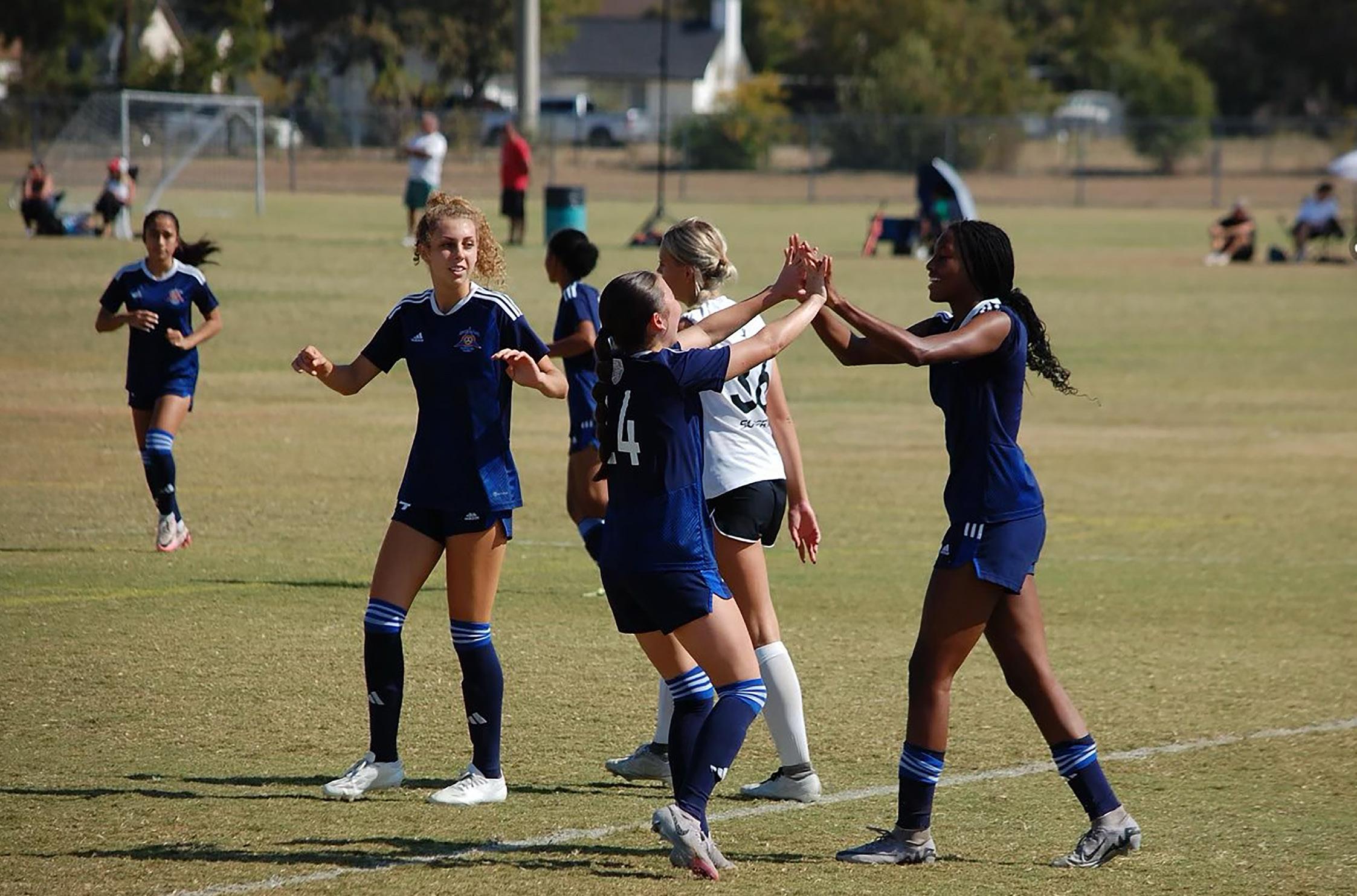
“Alex and Raelyn bring a unique combination of skill, intelligence and heart,” Flanagan said. “Their bond on and off the field elevates the entire team. They push each other to be better while keeping the game fun and competitive.”
Future Goals
As their paths lead to different states, both players view college soccer as a launching pad for their futures, whether that means playing professionally or pursuing careers beyond the field.
“I definitely want the chance to play professionally,” Han said. “But to get there, I know I need to keep improving in college.”
Young shares the same goals, explaining that she hopes to play professionally, “But I’m also excited to balance that with pursuing a strong academic degree.”
In the meantime, both players hope to inspire younger players chasing similar dreams. They have their own advice to gain success.
“Be gritty and expect challenges, but never give up,” Young said. “Perseverance is key.” Han emphasizes creating a positive environment on the field.
“Have fun,” Han added. “It’s easy to forget why you started, but enjoying the game makes you play better and stay confident.”
Having been a collegiate player herself, Flanagan offers her own advice for aspiring collegiate players. She says she tries to act as a support system for many girls, with the goal of providing a space for them to have fun playing low-pressure school games.
“Colleges aren’t just looking for talent –they want teammates with heart and work ethic,” Flanagan said. “There’s no doubt both girls bring talent, but also a commitment to their teammates that will serve them well in the years to come.”
Nora Ahearn, Nirvan Bhattacharya, Noah Stinchcomb

Greenhill coaches and athletes cite the importance of eating balanced meals with complex carbohydrates, fruits, proteins and
“When in doubt, color your plate,”
Junior Raelyn Young, who plays soccer,
Hydration is also vital. Electrolyte powders like Nuun and LMNT are popular. The Mayo Clinic recommends that teenage athletes drink around three liters of
Remain active in the offseason.
Houston says it is crucial for athletes to maintain their activity levels during the offseason. He advises 45-60 minutes of physical activity at least four to five times a
Not only does offseason training help avoid the challenges of getting back in shape, but it is also important for injury prevention, Houston
Junior Noora Qureshi, a girls field hockey captain announced a verbal commitment to play collegiately at the University of Pennsylvania, makes a point of
“It’s less work to run twice a week and not lose the endurance than it is to try to rebuild the endurance,” Qureshi said.
Getting 8-10 hours of sleep is recommended by the nation’s top medical experts. Utilizing checklists and maximizing time at school and the weekends are the best way to ensure sufficient rest, said Qureshi.
Sophomore cross country runner Evan Tsai recommends having a consistent routine, so your body’s sleep schedule is regulated. He also says to avoid screens before bed if possible.
“It’s not necessarily just how much sleep you get every night, but more when you go to sleep,” Tsai said.

Do not neglect proper recovery.
Foam rolling, compression boots, massage guns and cold tubs are all ways in which student athletes can recover after a workout. Qureshi says she prefers any recovery technique she can do at the same
your confidence,” Qureshi said. “I find I play better and also perform better on the academic side.”
Athletes also say it’s important to avoid over-scheduling and over-commitment.
“Understand when too much is too much,” said junior Trey Davis, who plays football and basketball.
Parsons Trade Exposes Cowboys’ Mismanagement
The Dallas Cowboys’ move to trade superstar Micah Parsons for Kenny Clark and two first-round picks was another step in the decades-long mismanagement of the team by owner and general manager Jerry Jones.
For the past 29 years, Jones has presided over a legacy of failure with a team that, while remaining socially relevant, has won nothing significant in the 21st century. The relinquishment of his general manager title is long overdue.
The latest episode in the Cowboys soap opera has been Parsons’ request to leave the Cowboys and his subsequent trade. One of the premier defensive players in the NFL, Parsons’ next contract was surely to be one that broke records.
Instead, Jones bypassed Parsons’ agent to float a “handshake deal” for a six-year contract with the superstar. The length of this contract is important. Typically, NFL stars sign contracts spanning three to four years, which allows them to negotiate higher salaries more frequently.
By trying to lock Parsons in for six years, Jones aimed to keep his salary below that of other premier edge rushers in the later years of his contract, opening cap space to pursue additional talent.
Jones’s meddling with Parsons’ contract resulted in the star player demanding a trade on Aug. 1. In a post on the social media platform X, Parsons proclaimed, “I no longer want to play for the Dallas Cowboys.”
Following this, the Cowboys front office scrambled to secure a deal before the start of the regular season. Their eventual trade for Clark and two first-round draft picks is mediocre at best. While a respectable defensive tackle on a team-friendly deal, Clark’s value is miles behind Parsons. Additionally, the likelihood the Cowboys will draft someone near Parsons’ abilities with these picks is close to zero.
In his first game with the Packers, Parsons showed his talent. Arriving just two weeks prior and thus constrained by a playing-time restriction, he recorded one sack and received praise for his performance. Parsons is the second player in NFL history to record 12 or more sacks in the first four seasons of their career.
The Parsons debacle isn’t an isolated failure on the part of Jones. As evidenced by his decisions to fire Coach Jimmy Johnson, sign Greg Hardy, trade Amari Cooper, draft Taco Charlton, and sign underperforming head coaches Jason Garrett and Mike McCarthy, Jones has a long history of mismanagement. The Cowboys’ dynasty in the ’90s owed
more to excellent coaching and sheer luck with the Herschel Walker trade than any genius from Jones.
Jones’ failure as a GM shouldn’t diminish his success as an owner. When he bought the team, they were losing $1 million a month. Now, they’re worth nearly $13 billion, with over $1 billion in annual revenue. Every year, they are in the spotlight of national media through TV personalities like Skip Bayless and Michael Irvin, who continue to popularize the team’s image in contemporary media.
What aspect of modern franchise management does Jerry Jones exemplify? His approach to player contracts, staff hires, and locker room management recently resulted

in another loss to the rival Eagles. As other NFC East move in a successful direction, the Cowboys seem to be stuck in the mud, or even worse, poised for another rebuild.
It doesn’t take a genius to recognize the obvious: Jones needs to retire. Holding on as general manager isn’t proof of strength, it’s a sign of cowardice. A cowardice that will continue to blind him from the team’s potential under a new general manager.
Until that day, however, the Cowboys will continue their disastrous ways, doing whatever it takes to stay relevant, but nothing to win titles.

Cate Simpson
ENext Chapter of Fall Sports
ach year, seniors graduate and leave behind big shoes for the next year’s athletes to fill. Some sports only lose a few athletes, while others lose close to a dozen. This year, the impact of graduation losses varies across different sports.
Among the programs adjusting to their new squads, the girls and boys volleyball teams are setting the pace. The girls team had an 8-2 record and boys volleyball remained undefeated as of Sept. 22.
Whether these teams will be this year’s norm or outliers remains to be seen. Last year was a particularly successful year for Greenhill athletics, and the coming months will test whether teams can meet that high standard.
Head of Athletics and Physical Education Jarrett Shine projects optimism.
every single one of us seniors truly believes this could be a potential year to win SPC,” said senior Davis Knocke, a team captain.
“
I wouldn’t say we’re not going to miss a beat, but I think we’re still going to be as competitive as we were last year.”
Team Adjustments

“I wouldn’t say we’re not going to miss a beat, but I think we’re still going to be as competitive as we were last year,” Shine said.
Keeping Hopes High
The girls volleyball team had two players commit to NCAA Division III colleges last year, including one captain. The current captains are seniors Jacquelyn Dishman and Kendall Johnson and junior Julia Deibert.
“It was a big loss this year, but our captains this year are incredibly fit for the job of leadership of the program,” girls volleyball Head Coach Tati Deibert said.
The boys volleyball team started the season with a win against St. Mark’s School of Texas, which placed first in the Southwest Preparatory Conference last year.
“It marks exactly where we want to be in terms of the beginning of the season and where we need to start out, because I’d say
Field hockey lost two seniors last year, including an NCAA Division I recruit, leaving the team to adjust to the loss of a key player. This has pushed this year’s team members to raise their level of play.
“I feel like the whole team has really stepped up to the challenge and been willing to try different things, listen to Coach [Brittany] Hawkins, listen to the upperclassmen, learn from each other, and help each other,” Noora Qureshi said.
The football team lost 11 seniors last year, all of whom were starters. Football Head Coach KJ Williams says every team needs a different type of motivation, and the challenge lies in finding the right type for this year’s young team.
“I feel like the whole team has really stepped up to the challenge and been willing to try different things, listen to Coach Hawkins, listen to the upperclassmen, learn from each other, and help each other.”
“For the most part we are a very young football team, and whenever you have a young football team, regardless if you did really well last year, or you didn’t do very well last year, you’re going to be in the building

phase, trying to reach your full potential.” Williams said.
Aligned Mindsets
Despite the different challenges and adjustments each team faces, coaches and players say they share one common theme: resilience and adaptation.
“I think the intensity that we need to bring when we’re competing is very important,” Shine said. “If we attack every game with that type of intensity, knowing that we have an ability to win, and have the confidence that we’re the best athletes on the field or on the court, then I think that’s going to go a long way in terms of success that we have within the Athletic Department.”
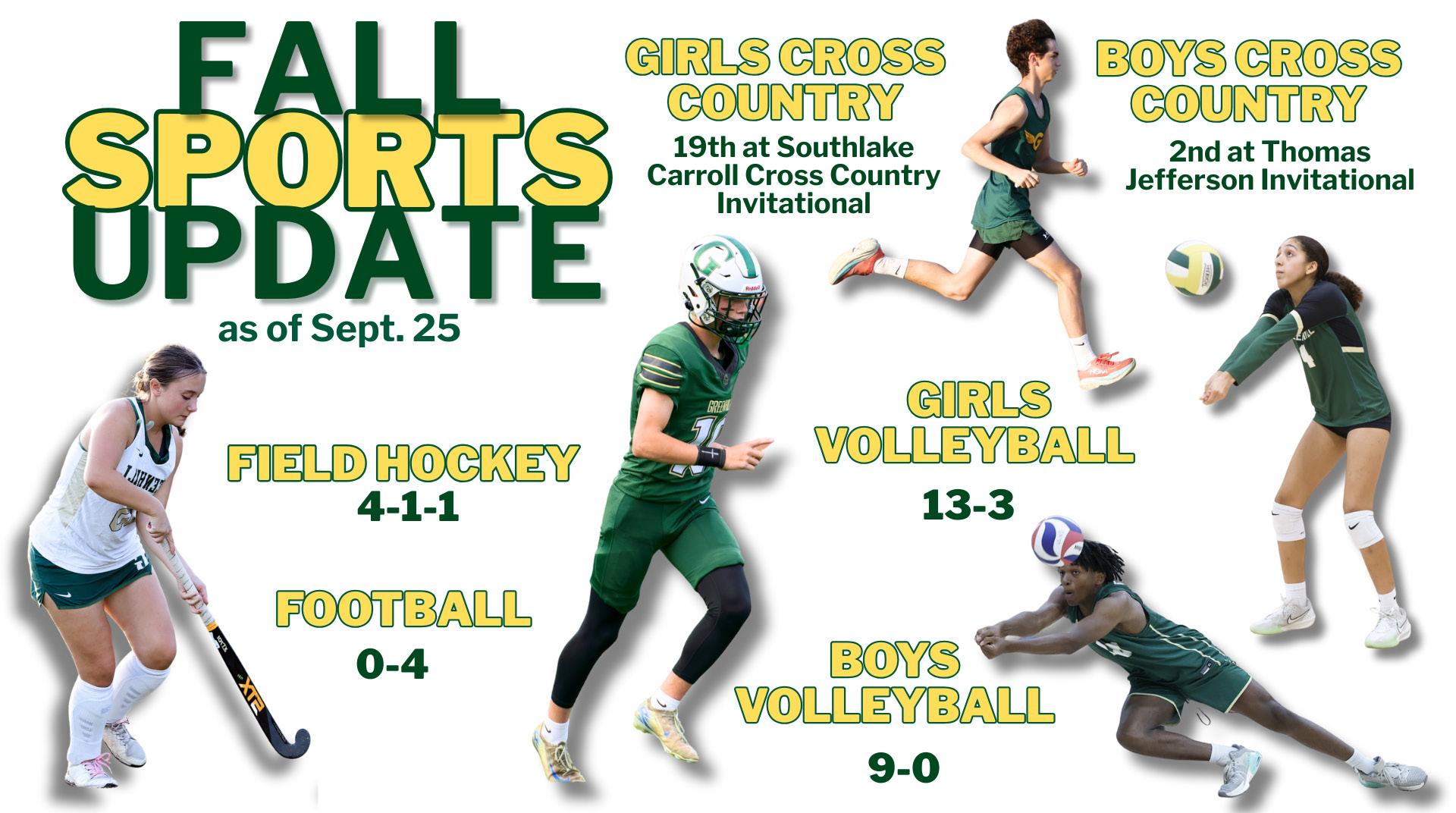
Greenhill Hires New Athletic Trainers
Nora Ahearn
After the summer departure of Greenhill’s director of sports medicine and an athletic trainer, Head of Athletics and Physical Education Jarrett Shine launched a search for replacements.
Shine describes the departures of Director of Sports Medicine Nick Saldivar and athletic trainer Aliki Pappas as a “shock” that left him limited time to find replacements. Thus far Shine has hired an experienced athletic trainer on a permanent basis and has added two part-time trainers in a trial arrangement.
Michael Meadows, a former collegiate trainer at the NCAA Division II level, started to work at Greenhill in September as an athletic trainer.
The second piece of Shine’s solution to the summer departures is the hiring of parttime trainers Allison Whatley and LeslyLoudmar Mathurin through an outside contracting firm.
“We’re going to test it out and see if [external contracting] is a viable option for us long term,” Shine said.
Turnover
Stability with its athletic trainers has eluded the Greenhill Athletic Department in recent years. The department has cycled through four athletic trainers in the span of four years, with two employed at any given time.
Meadows says he aims to “reestablish the trust” in the school’s sports medicine program.
“We’ve had a lot of turnover here, and that shows,” Meadows said. “Like my first day, I had multiple people come in, and when
I introduced myself to them, they were like, ‘Oh, are you going to be here next year?’”
Finding someone who could help rebuild that trust between trainers and athletes and athletic staff was crucial during the hiring process, Shine said.
Meadows previously worked at Missouri Western State University, which competes in NCAA Division II athletics. His collegiate experience was appealing, according to Shine.
“It was a natural fit for us, and he gets our community,” Shine said. “He’s coming from the college ranks, so he understands how we’re trying to improve our athletic training staff and the things that we offer and how we support our student athletes.”
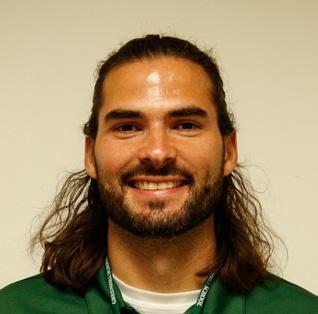
Shine says that hiring full-time trainers has become more challenging because of burnout within the sports medicine field. That has caused a shortage of athletic trainers, Shine said.
An additional challenge is the desire of athletic trainers to find work at a higher level of sports medicine, Shine said.
“Some of them don’t really want to work at the high school level,” he said. “They want to do contract work, or they want to work in hospitals and do clinical stuff.”
Going Forward
As he settles into his new job and adjusts to the world of high school athletics, Meadows says he plans to improve the organization of Greenhill sports medicine. This starts with communication across the Athletics Department, he said.
“That’s an area that I think needs a little bit more organization,” Meadows said.
He also plans to make changes in a program that allows Upper School students to receive a sports credit for assisting the athletic trainers. Meadows says he will assign specific responsibilities to each student aide.
The aides work within a legal framework, requiring Meadows to make sure the students comply with the Health Insurance Portability and Accountability Act, or HIPAA, which requires strict privacy protocols.
Meadows also aims to tailor the work of student aides to their individual interests. For example, Meadows says he plans to let
senior Naomi Stewart observe treatment evaluations.
“I’m excited,” Stewart said. “Everything’s been going pretty smoothly, so hopefully that continues.”
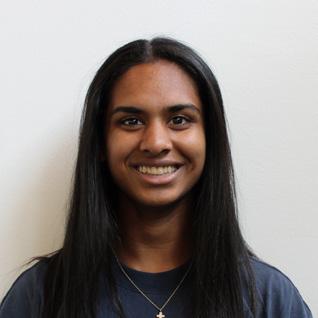
Though there is more access to certain resources at the collegiate level, Greenhill is “very well equipped,” Meadows said. “People seem like they really want this to succeed, and so it just it seems like a welcoming environment with a lot of potential.”
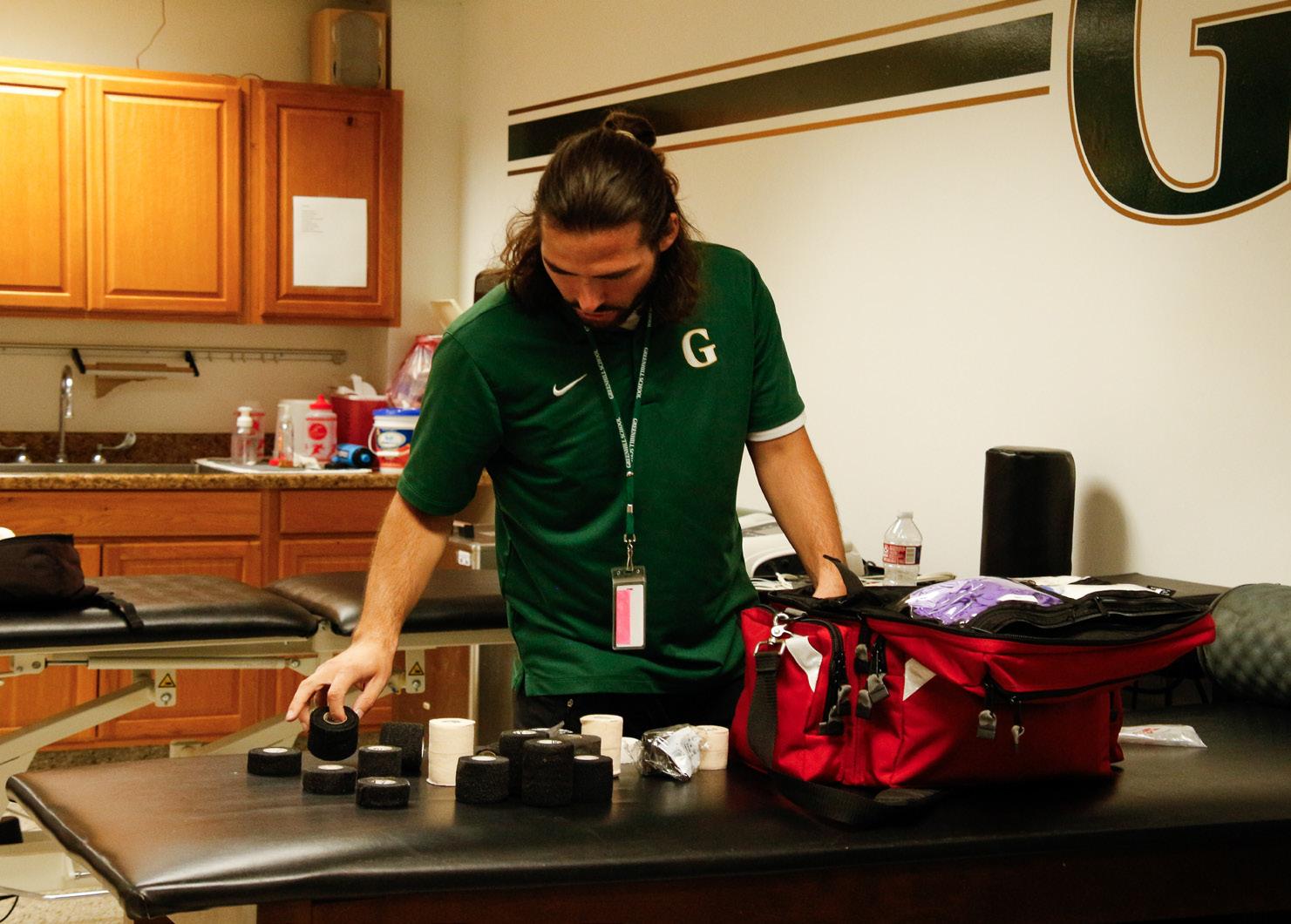
Sagoe Sisters Welcomed to the Volleyball Team
Girls volleyball Head Coach Tati Deibert recalls the first time she ever laid eyes on the new set of triplets joining her team.
“This is my first time ever coaching triplets,” said Deibert. “I remember joking with them during the first few practices about how to tell them apart.”
Dara, Essie and Lola Sagoe entered Greenhill this year. It took time for the three to get familiar with the team environment, Deibert said.
“They were like magnets to each other,” Deibert said. “During water breaks, instead of going in with the team they would just huddle together.”
Coming to the Hill
The triplets’ journey to Greenhill began when their mother toured the campus last year and liked what she saw, according to Lola Sagoe. Afterward, the girls applied to the school and got accepted.
The girls tried out for the volleyball team and first met their teammates during spring practices on May 12-16.
“Being new to the school I feel like these spring practices really helped us get to know everyone,” Essie Sagoe said. “When the season actually started nothing was awkward, since we had already met everyone.”
To further acclimate the new members, Deibert decided to have a talk with the team about having them put in extra effort to help the triplets blend in and get used to the school.
In August, the team bonded through various events. These included a session in which players painted a portrait of a teammate, attended a team sleepover, held a potluck meal, and met for brunch at Toasty Breakfast & Lunch. The team also did a trust-building activity in which players were blindfolded, spun in a circle and then guided by teammates as they moved about.
“All the team bonding events helped us get used to everyone on the team and develop a better connection,” Essie Sagoe said.
“The [volleyball] program is meant to be inclusive,” Deibert said. “This is a big year for them, coming to a new school and a new team. We all have a job to help them feel welcome.”
First Steps
The Sagoe triplets started playing volleyball at age seven when their mom signed them up to play on a recreational team. As seventh graders, they joined a club team and began to develop their skills. Dara and Lola began playing the setter position, while Essie became an outside hitter.
Last year, the triplets played for a team at Dallas Premier Volleyball Club and also for Rock Hill High School in the Prosper Independent School District.
This year, the triplets decided to stop playing club volleyball. According to Lola Sagoe, they didn’t want to play in college and their schedule was getting too intense.

“If we were lucky and finished all of our work earlier, we could go to bed by 11 on a good day,” Lola Sagoe said. “It was getting hard to manage everything.”
Dara Sagoe says stepping away from club play has allowed her to focus more on school.
“When we had travel tournaments my grades would always drop because I would have so many assignments but not enough time to do them,” she said.
Team Chemistry
The Sagoe triplets have fit in well with the Greenhill girls team, which had amassed a 13-3 record by late September.
“They already know each other so well and it’s really benefiting the team as a whole,” said junior Jordy Wilkofsky. “They know how one another plays, which helps the flow of our game.”
The Sagoe sisters say that they have enjoyed the team environment.
“Greenhill volleyball is very enjoyable,” Essie Sagoe said. “I actually want to go to practice and look forward to playing in the games. I’m excited to be there and see everyone, because the team has very good chemistry.”
Although the Sagoe sisters say they don’t plan on playing volleyball in college, they have high hopes for the upcoming high school season. This includes talk of a Southwest Preparatory Conference championship.
“I think if we can stay focused during practices and just keep getting better, we have a shot at winning SPC,” Essie
said.
It’s hard to say which of President Donald Trump’s brazen actions has been the most autocratic so far, but his current congressional redistricting push is certainly near the top of the list.
For Trump, the stakes of the 2026 congressional elections are high. They will make or break his legislative agenda, especially with low second term approval ratings and the rising unpopularity of his recent legislation, the One Big Beautiful Bill Act.
In June, Trump called for Republican lawmakers in Texas to redraw the state’s congressional maps – a rare and disturbing move, since redistricting is typically done once a decade after the census. Trump said the Republican Party is “entitled” to these seats. This attitude is blatantly anti-democratic. Seats do not belong to a politician or party; they belong to the people.
Texas Gov. Greg Abbott, a MAGA loyalist, called a special session of the State Legislature in July and added gerrymandering to the agenda. The maps produced by the legislature’s Republican majority will likely result in five more GOP seats in the U.S. House of Representatives following the November 2026 midterm elections.
Though Texas Democrats attempted to fight back by leaving the state and denying the majority a quorum, their efforts fell short. Abbott ultimately signed off on the new map on Aug. 29.
Such mid-decade gerrymandering erodes the democratic process.
No accurate census data is available to confirm each vote carries equal weight. This distorts the political landscape by manipulating district lines to favor the Republicans, undermining a core principle of democracy: elections should reflect the will of the people. Instead, they will reflect the schemes of those in power.
Equally troubling, under the new map, the influence of a white Texan’s vote is three times greater than a Latino Texan’s vote and five times greater than a Black Texan’s vote, according to a Time magazine analysis. Texas is effectively signaling to the rest of the country that equal protection under the 14th Amendment is not guaranteed. We risk returning to a bygone era, one that dilutes racial progress.
But Democrats only have so much power to fight back. The Republicans have control over all branches of the federal government. And with the current congressional district mapping, Democrats will need to win the national popular vote by two to three percentage points to gain control of the House in 2026.
What has ensued is a redistricting “arms race,” with an increasing number of states threatening to redistrict to counter each other’s influence. In August, the Democratic governor of California, Gavin Newsom, set in motion a plan to redraw his state’s congressional maps to produce additional Democratic seats. If successful, California would cancel out the five new Republican congressional seats created by Texas redistricting.
Meanwhile, two other Democratic governors – Maryland Gov. Wes Moore and New York Gov. Kathy Hochul – said they would be willing, albeit reluctantly, to fight Republican gerrymandering.
Republican Gov. Ron DeSantis of Florida is ready to counter the Democratic countermoves, especially after the President’s push for a new mid-decade census that would remove undocumented migrants from the total population figures that determine congressional apportionment. With the results from that census and subsequent redistricting, Florida could gain at least three new seats.
To counter the Republican efforts, Democrats have been forced to take actions that could have adverse consequences over the long term. On one hand, it is necessary to counteract the GOP’s gerrymandering to obtain the closest thing to accurate representation. But the long-term effects could be detrimental for democracy.
Weaponizing district lines against opposing parties would place the power of voters in the hands of politicians, reducing competition for certain parties and eliminating incentives to pass policies based on political compromise. The result would dilute political accountability and increase polarization, creating a government that prioritizes partisanship over a fair reflection of its people’s interests.
Trump’s mid-decade redistricting is a bad idea that erodes American democracy.


Hurley
The criticism Texas has faced for adding five Republican-leaning districts to the latest redistricting map passed by the Texas State Legislature is severely misplaced. This so-called “antidemocratic power grab” is simply a state exercising its right to redistrict during a state legislative session.
A mid-decade redrawing has been done before, like Georgia in 2005. The U.S. Constitution does not mandate that lines be frozen until the next census. States have always held the authority to adjust representation when conditions change, and that authority is a key tenet of federalism. To claim Texas’ decision is illegitimate ignores constitutional design.
Additionally, partisan redistricting has been a feature of American politics since the nation’s earliest years. The response by Democratic Gov. Gavin Newsom to try to neutralize Texas’ new GOP seats by redrawing California’s congressional districts eliminates the claim of ethical high ground if they also use partisan map drawing.
With both Republican and Democratic parties engaging in this middecade redistricting ahead of the 2026 midterms, the only difference between the two is that Texas acted first.
Meanwhile, the Democratic governors of Maryland and New York have suggested a willingness to redraw their maps to secure more Democratic seats in the House of Representatives. Clearly, we are dealing with what might be described as a redistricting arms race. But that is not necessarily a bad thing. Competition for control of seats has always been a part of American democracy and federalism.
Critics of the Texas redistricting refuse to consider the impact caused by the influx of population to cities like Houston, Austin and Dallas. It has been estimated that 2 million new residents have moved to Texas since the 2020
census. Ignoring this shift in demographics would effectively deny representation to millions of voters until the next census. Why should communities wait until the next census in 2030 for congressional districts to change?
Texas legislators are doing their constitutional duties by updating congressional districts to keep up with the increasing population. By updating the map, legislators can ensure equal representation in the areas that experienced a significant population boom.
The fairness argument of redistricting cuts both ways. Republicans and Democrats enjoy the structural advantages of gerrymandered district lines that overrepresent their voters. Democrats have benefitted from carefully drawing out their districts while claiming outrage when Republicans take similar steps. Since neither side has clean hands, trying to vilify one side or the other is plainly foolish.
It’s false to suggest that Republicans are attempting to sidestep the will of the voters because President Trump views the 2026 midterms as crucial to his political agenda. One man’s political agenda is not the sole factor behind the change. Texas is responding to unprecedented population growth and an already competitive political environment, spurred on by Democrats and Republicans alike.
Meanwhile, Gov. Newsom is floating a ballot proposition to bypass the independent citizens’ commission responsible for drawing California’s districts. If anyone should be accused of circumventing their constitutional boundaries, it’s California Democrats.
Regardless, Newsom’s claim that he will “fight fire with fire” regarding Republican redistricting is natural. This open competition between states shouldn’t be taken as evidence of abuse of power. If citizens disagree with their governors’ redistricting, they can hold their elected officials responsible at the polls in the 2026 midterm balloting.
Reflections from Hunt, Texas
Camp Waldemar is my happy place. Since 2021, I’ve been spending a month every summer at the Hill Country camp along the North Fork of the Guadalupe River. This year marked my last as a camper, my so-called Hilltopper Summer.
I never expected it to be over in just six days.
It rained the entire first week of camp. And then, on the night of July 3, there was a violent rainstorm that somehow felt different.
On July 4, we awoke to no power or running water. We were told to stay in our cabins but given no other information. Even our counselors knew nothing.
It was still raining on and off and unusually hot and humid, even for a Hill Country summer. There was something else unusual about the day: There were helicopters overhead periodically, and we watched them flying without knowing their significance.
We were excited when one helicopter
landed to offload cases of water. The one bottle each of us got. That lone bottle would be our last water for 40 hours.
Once we were allowed to walk to nearby cabins, we saw that a rushing torrent of water had cut through the rifle range and scattering mud and rocks. The emeraldgreen river now ran high and brown.
Bored out of our minds, we still had no hint of the tragedy unfolding only a few miles away.
On the late afternoon of July 4, my friends and I managed to get the radio on my iPod and learned about the deadly flash floods. Later that day, I scribbled the shocking news in my journal: “16 people in Hunt were reported dead and 20 people from Camp Mystic were missing.”
We all fell silent.
Camp Mystic, only four miles away in our treasured Texas hills, was especially hard hit. Not wanting to inflict this pain on other campers and counselors, we kept the secret within our cabin.
Later that night, the camp arranged for us to have a makeshift dinner in our big lodge with whatever food that hadn’t gone

bad. Later, as we made our trek back to our cabins, I looked up at the sky.
“The sky was so eerie, so beautiful, and so pink,” I wrote in my journal. “It looked like cotton candy. But I couldn’t help looking at it and wondering if it was the lost souls looking down on us.”
That night my cabin stayed up until 4 a.m., feeling like it might be our last night in our beloved camps. We joined the other Hilltoppers for a midnight dance party, and later, climbed into one bunk and talked.
The next morning, our camp directors told us that we would be leaving. While our camp was holding up, nearby camps, campgrounds and towns were devastated.
Tears immediately came pouring from every girl’s eyes. We stripped our beds and repacked our stuff, most of it untouched. As we waited to evacuate, we all sat together savoring our last moments and preparing for what was to come.
One by one, we filed onto Hunt Independent School District buses. They warned us that what we were about to see wasn’t pretty. As we passed through the mangled gates, we sang camp songs, our voices quivering with emotion.
Escorted by police cars, we drove 40 minutes to meet our families, passing scenes of horrifying destruction. Homes were destroyed, cars flipped upside down in fields and canoes wrapped around trees. Even the giant cypress trees had been torn from the ground, obstructing the roads. We watched search and rescue teams hunt for the dead and missing, and volunteers helping in any way they could.
We got out without further incident, but even now, the memories hurt. Of course, it’s far worse for the lost children and their families. I can’t help but think they would still be here today if the proper precautions had been taken. Natural disasters are inescapable, but, in hindsight, we know how reckless it was to build camps and campgrounds in the floodplain.
I was one of some 850 people evacuated from Kerr County. For those of us who escaped the raging waters, we can only hope and pray that the nearly 140 lives lost, including 27 girls from Camp Mystic, rest in peace.
Rising Political Violence
In the aftermath of the assassination of conservative activist Charlie Kirk on Sept. 10, turmoil has once again consumed our nation. Amid the swirling emotions, one truth is glaringly obvious: political violence needs to stop.
Over the past five years, America has witnessed a surge in political violence.
On Jan. 6, 2021, an estimated 10,000 supporters of losing presidential candidate Donald J. Trump stormed the U.S. Capitol to prevent the certification of Joe Biden as president. Some 2,000 Trump supporters overpowered police and rampaged through the Capitol.
Since then, there have been several more acts of political violence, including two assassination attempts against Trump as he campaigned to return to the White House in 2024. And in June, former Minnesota House Speaker Melissa Hortman, a Democrat, and her husband were shot and killed in their home in what authorities have described as a politically motivated assassination.
In each case, there were reports of individuals defending or even celebrating the attacks. The attempted justification of acts of extremism reflects the deepening political polarization in our nation. Divisive rhetoric runs rampant on social media and seeps into day-to-day life.
Kirk was no stranger to controversial,
even divisive, rhetoric. He gained an international following as a blunt-talking free-speech advocate in appearances at college campuses around the country. But in those appearances, Kirk staked out sometimes provocative views that pleased many on the MAGA right while offending other Americans on the political left. At the moment of his assassination, he was answering a question about gun violence during an appearance on the campus of Utah Valley University in Orem, Utah.
Kirk’s death has stoked the fires of division, with President Trump, Vice President JD Vance and other Republican politicians blaming the assassination on the rhetoric of “radical” leftists. Democrats have accused Trump and his administration of exploiting the assassination to suppress critics. Where this latest violent turn of events leads is an open question.
and Trump administration threats to prosecute and impose other sanctions against individuals and legal organizations seen as opponents. At the same time, Greenhill prioritizes teaching students how to disagree respectfully, highlighting our values of excellence, integrity, compassion

Greenhill hasn’t been immune from a less virulent form of political polarization that brought us to the Kirk assassination
More and more, rifts between classmates and friends form when beliefs diverge. As ideological divisions deepen, it is imperative for Greenhill to combat the tendency of individuals to retreat into radicalized echo chambers. As a community, we need to equip students with comprehensive media literacy skills and the tools to cultivate civil discourse. What’s more, we need to come together as a community to denounce and actively oppose political violence across the ideological spectrum. Deeply held beliefs should never be a justification for violence, and we call on the Greenhill community – with all its varied political passions and beliefs – to unite in this commitment.
EDITORS-IN-CHIEF
Nora Ahearn
Kate Ponnambalam
Sasha Wai
John Hurley
EXECUTIVE EDITORS
Rory Liu
Lylah Pouratian
Ella Sadka
Vedant Subramanian
Justin Wu
DEPUTY EXECUTIVE EDITOR
Noor Zaman
MANAGING EDITORS - PRINT
Vivian White
Kaitlyn Yoo
MANAGING EDITORS - ONLINE
Jin Huang
Scarlett Song
Penelope Stone
ASST. MANAGING EDITORS
Aanya Bhoria
Victoria Gonchar
Sadie Werner
DIRECTOR OF PHOTOGRAPHY
Lillian Smith
NEWS EDITORS
Vivian White and Kaitlyn Yoo
FEATURES EDITORS
Cindy Chou and Khushi Punnam
ARTS EDITORS
Sadie Werner and Victoria Gonchar
SPORTS EDITORS
Jordan Arbuckle and Aanya Bhoria
VIEWS EDITORS
Talia Sidikaro and Cate Simpson
STAFF WRITERS
Noa Pouratian
Nithya Rao
Julia Bella Frankfurt
Nirvan Bhattacharya
Evan Huang
Noah Stinchcomb
Marleigh Massoud
Aashi Punnam
ADVISOR
Gregg Jones
Have a response? Opinion? Original Idea?
Email the Editors-in-Chief:
ahearnn26@greenhill.org ponnambalamk26@greenhill.org wais26@greenhill.org
EDITORIAL POLICY
The Evergreen is an independent, studentrun newspaper serving the Greenhill School community. It is printed six times during the school year. Print circulation is 900 copies. Past issues are archived at issuu.com/ghevergreen. Our staff upholds a code of ethics that values honesty, integrity, accuracy and responsibility. Our mission is to help our community interpret campus, local, state and national events through content written and edited by students.
The Evergreen welcomes letters and emails from readers. We reserve the right to edit submissions for accuracy, grammar and length. The Evergreen will not publish material that we judge to be libelous, or obscene, invades privacy or constitutes hate speech. The staff editorial represents the opinion of The Evergreen staff, not necessarily that of Greenhill School.
ADVERTISEMENTS
The Evergreen welcomes advertisements, but we reserve the right to refuse an ad. Business inquiries should be directed to Ella Sadka: sadkae26@greenhill.org
CORRECTIONS & CLARIFICATIONS
To request a correction or clarification, email ahearnn26@greenhill.org, ponnambalamk26@ greenhill.org or wais26@greenhill.org
& Rants Raves

A RANT to parking. After hours of classes, leaving school is one final challenge in the day. With students from all grades trying to leave around the same time, a system of staggered traffic is much needed.
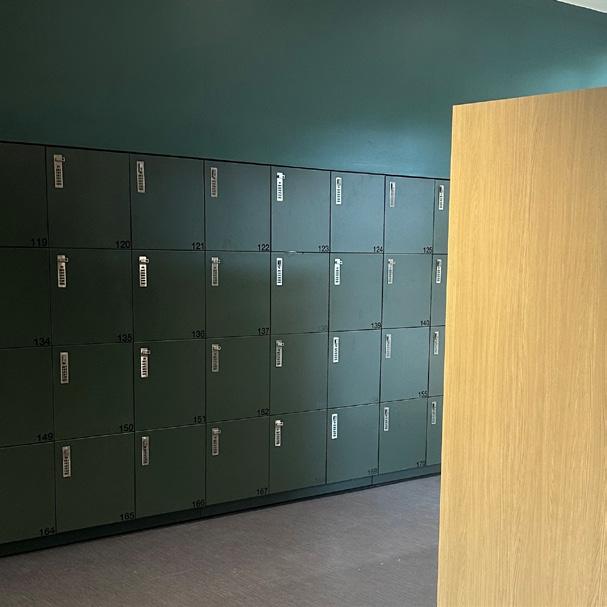
A RAVE to Upper School South (Fulton Building) renovations. Over the summer, the Upper School received a makeover. If you haven’t stopped by, check out the lockers, offices and classrooms to see the Upper School’s new look!

A RAVENT to our August return to school. While it is fun to see friends and share memories from the summertime, it takes a while for everyone to readjust to the school workload.

A RANT to early morning sports practices. After working hard on the field and in the High Performance Center before school, athletes have to rush to get ready for the long academic day ahead.
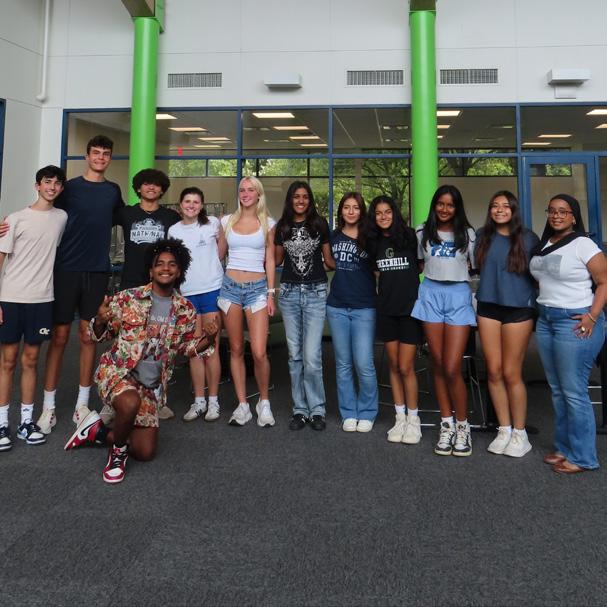
A RAVE to the new Activities Board. A new affiliate of the Student Council, the board was created to organize events, projects, and functions for Upper School students. Let’s get ready for some exciting things!
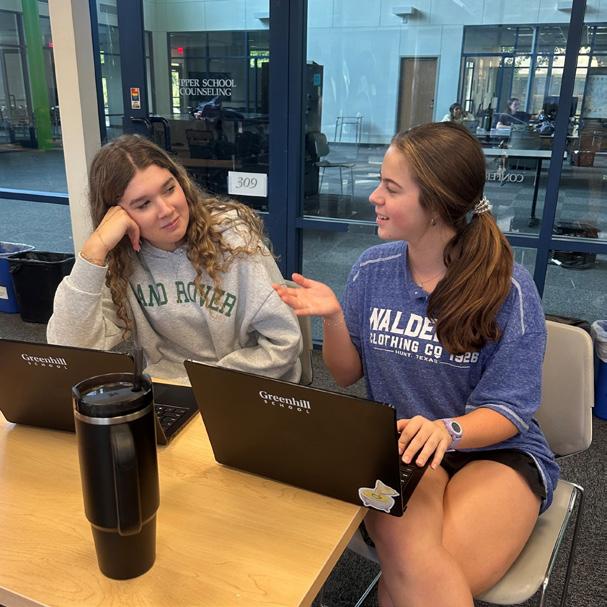
A RAVENT to the phone ban. Although it allows us to spend more time conversing in-person and less time looking at a screen, the school day is very different without phones. Can we please get walkie talkies to contact our friends across campus?
The Costly Silence of the Bystander
Kate Ponnambalam
Boys snicker, calling a female classmate a “cow” as some students watch in embarrassed silence and others smile with approval. The girl bravely battles tears as she rushes out of the classroom.
Students audibly mimic the stutter of a classmate making an announcement during an assembly. No one chastises them or even urges them to be quiet.
The unchecked hum of misogyny reverberates as groups of guys casually call a passing girl “chopped,” slang for unattractive. Hurt feelings along with callous laughter hang in the air.
Each of us can recall some moment when we felt embarrassment, anger or even heartache as we witnessed another student confront abuse.
In far too many schools, when students witness injustice or cruelty, we mistake our silence for a noble refusal to join the bullying. Students see harassment, exclusion or verbal abuse happening in hallways and classrooms, yet we turn away or remain quiet, telling ourselves, “It isn’t my problem.”
But silence is never neutral. In his “Letter from Birmingham Jail,” Dr. Martin Luther King Jr. wrote, “We will have to repent in this generation not merely for the hateful words and actions of the bad people but for the appalling


wounds demand our care and protection. We would understand how our silence or giggling is a moral failure in a moment that begs for courage. We might speak up, not because we have a sharp comeback or perfect response, but because our words tell the victim that we see the injustice and their hurt matters.
Greenhill often talks about cultivating leaders, but true leadership begins in those uncomfortable, unchecked moments when it is easier to do nothing. Leadership does not merely exist in college applications or in club or team titles, it lives in the moment someone decides to act when everyone else stays quiet.
aside tells the victim and our community that many of us value ease more than justice. To break the cycle of apathy, we must ask ourselves: When challenge injustice or will I be remembered
and can require extraordinary courage. failed at this more times succeeded. Yet when we are all inevitably the victims of unkindness, we hope others nearby find the heart to choose defense over comfort, imperfect words over easy silence.
seeds of courage in us all: “Injustice anywhere is a threat to justice everywhere. We are caught in an inescapable network of mutuality, tied in a single garment of destiny. Whatever affects one directly, affects all indirectly.”
network of mutuality” where, as each of us chooses kindness and courage, we create a more honorable community where empathy fuels action and brave words triumph over cruelty.

As the school year kicks off, coping with stress is crucial. The Evergreen asked Upper School community members how they manage pressure as school demands mount. Here is what they had to say:

by
